On Monday, Feb. 6, two massive earthquakes with magnitudes of 7.8 and 7.6 devastated southeastern Turkey and northwestern Syria.
Riddled by war and lacking infrastructure, the affected region — which had not seen any major earthquakes in over 200 years — was far from prepared to handle a disaster of this level. The Turkish government’s slow response and the extreme rain and cold weather plaguing the area only seemed to worsen the situation.
As rescue teams continue to search for survivors, the death toll between Syria and Turkey has steadily surpassed 20,000. This number only continues to rise, accompanied by the millions of people who have been injured or displaced.
The impact of these earthquakes has spread far beyond the physically affected region; at the Claremont Colleges, Turkish and Syrian students have felt these effects significantly.
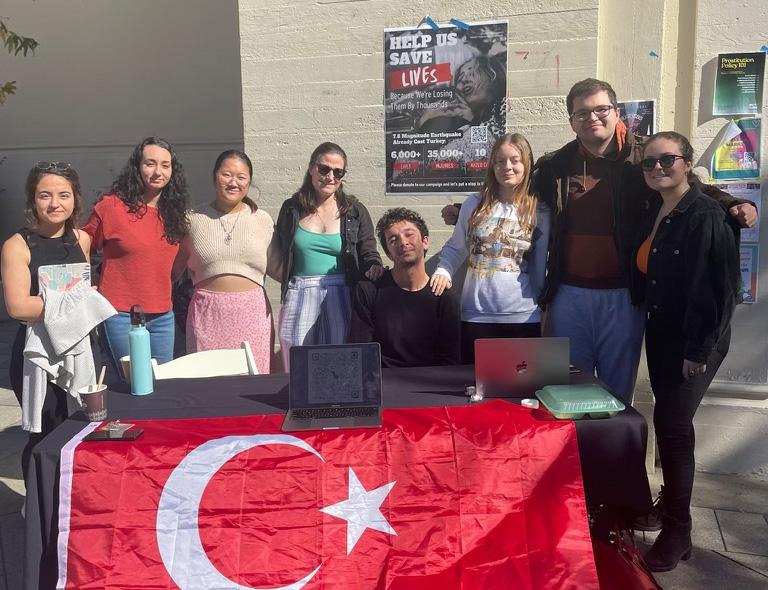
Ismail Kavuran HM ’26, an international student from Turkey, has been severely affected by the earthquake.
“I’m from Elazığ and Şanlıurfa, which are two of the ten devastated cities,” he said. “Since Monday, we have lost a lot of friends — I have personally lost 10 friends already — so it has been really emotional to process all of this.”

Kavuran commented that this has been an especially difficult period for him because he understands the trauma that his people are going through, especially after witnessing a 6.8 magnitude earthquake in Elazığ three years ago.
Charlene Baghdadi CM ’25, an international student from Syria who
New ULPs allege subcontracted workers take brunt of Pitzer’s union busting
has family in Aleppo, has also been directly affected by Monday’s events. During the earthquake, she received a message from her dad’s side of the family.
“They were freaking out, because they thought they were being bombed,” Baghdadi said. “Out of nowhere, their chandelier fell on the floor and the wall above my cousin’s head completely cracked open.”
She explained that, luckily, her family was able to escape their collapsing home safely. They retreated to their car to wait out the aftershocks, which continued throughout the rest of the day.
“They didn’t know if their building was going to fall, which was just really scary,” Baghdadi said. “Obviously, no one could really go to physically help them in that situation.”
While many students have direct ties to victims of the earthquake, the ones that haven’t still mourn the tragedy.
“We don’t have to have lost close family members to be affected by this,” Bilge Tayyar CM ’24, an international student from Antalya, Turkey, said. “This is huge.” Serenat Arpat PO ’25, originally from İzmir, explained how the earthquake has affected her everyday life as a college student.
“Since the earthquake happened, that is literally everything that I can think about,” she said. “There’s still school going on, but at the same time, it’s really hard to focus on classes [while] receiving news about an additional person dying back home.”
Tayyar expressed a similar
This article was produced in partnership with Claremont Undercurrents, a student publication dedicated to covering labor, abolition, Palestine liberation and other leftist organizing on campus, and is also published at undercurrents.ghost.io.

In a series of demonstrations this week, dozens of Claremont College students, Pitzer College workers and union leaders called Pitzer administrators’ and trustees’ attention to an Unfair Labor Practice (ULP) filed by the union Tuesday, alleging the college broke federal labor law by discharging two dining workers who supported the union.
The demonstrations included delegations to a Pitzer Board of Trustees meeting Thursday afternoon and to Pitzer Vice President Jim Marchant on Tuesday, each of which had over 60 participants. In both, workers distributed copies of Tuesday’s ULP.
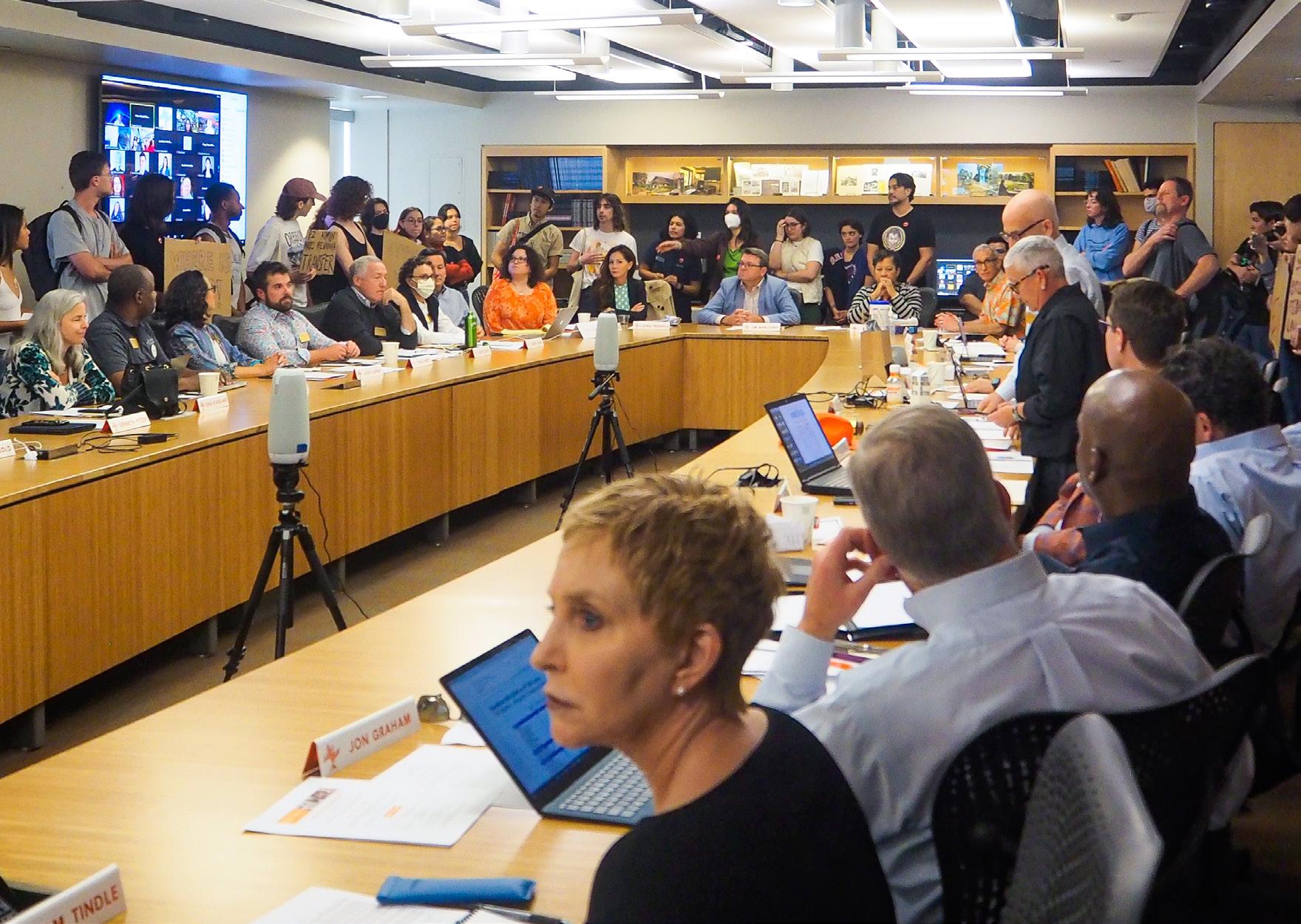
The ULP is the third that the union has filed against Pitzer and Bon Appétit Management Company (BAMCO) since Pitzer’s staff unionized last August. The complaints focus on the mistreatment
ASCMC resolution to return to pre-pandemic social life sparks controversy
FIONA HERBOLD & ANNABELLE INK
On Feb. 6, students crowded into the Mary Pickford Auditorium for the Associated Students of Claremont McKenna College (ASCMC) weekly Senate meeting to discuss a resolution proposed by Claremont-Mudd-Scripps student-athlete Austin Andersen CM ’25 on Jan. 23.
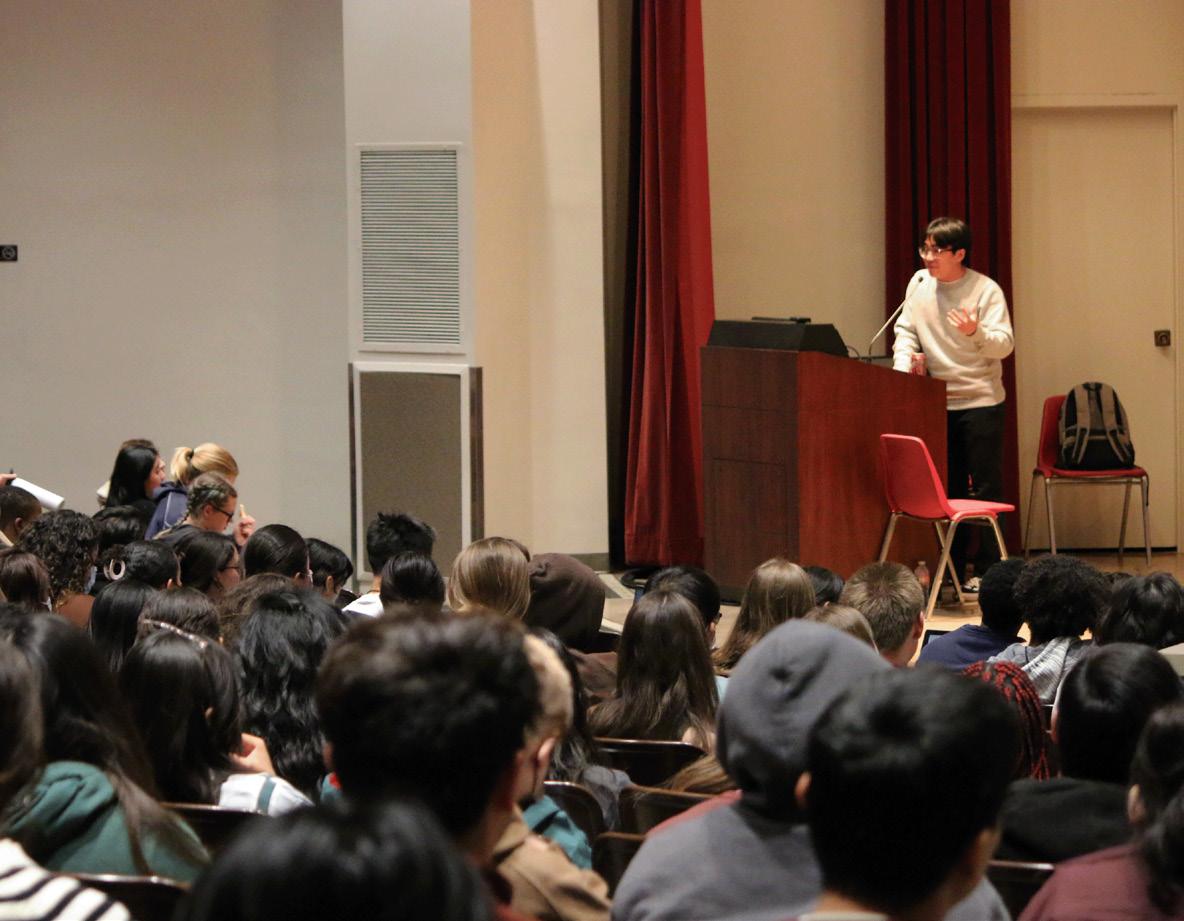
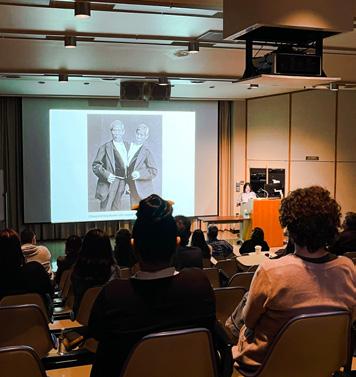
The resolution demands that the Dean of Students Office (DOS) lift “arbitrary and unreasonable” restrictions on Claremont McKenna College’s social life and restore the college’s pre-pandemic party culture.
ASCMC Senate meetings typically have about 20-30 students in attendance. At Monday’s meeting, however, long-time senators and ASCMC officers found themselves ambushed with over 250 attendees due to unprecedented levels of interest around the resolution.
The resolution highlighted concerns over the lack of 5C parties, the 100 person cap on student-hosted events, the prohibition of the use of event funds to purchase alcohol and the requirement of administrative supervision at events with over 20 students. It was passed almost unanimously at ASCMC’s Jan. 30 Senate meeting. Other members of ASMC, howev-
er, strongly opposed the resolution but felt outnumbered.
“It was not a representative sample of the student body at all, and was majorly white students and majorly athletes,” ASCMC President Josh Nagra CM ’23 said.
When the resolution passed, students formed a committee devoted to “protecting social life” at CMC, sparking conflict throughout the college.
Nagra commented that the resolution glorifies CMC’s pre-pandemic party culture. However, according to Agosto Aliaga CM ‘24, this is not the resolution’s intention.
See ASCMC on page 2
of three workers subcontracted through BAMCO, as well as other illegal anti-union actions taken by Pitzer management.
UNITE HERE! Local 11 representative Natasha Wong PZ ’22 alleges that Pitzer began subcontracting workers through BAMCO after Pitzer staff went public with their union campaign last spring as an attempt to exclude new workers from the union. Five votes were contested in last December’s union decertification election. According to UNITE HERE! Director Noel Rodriguez PO ’89, some of these votes belonged to subcontracted workers, whom the administration claims are not represented by the union.
“Pitzer has fought hard to keep them out,” Rodriguez said. “We’ve demanded that they become Pitzer employees and part of the union over and over and over and Pitzer has repeatedly refused our demands.”
Wong said managers escalated unfair labor practices against subcontracted workers when contract negotiations resumed this year, after Pitzer’s union tk .
“Since the decertification election, [managers] have started really running a pretty heavy anti-union campaign,” Wong told TSL.
Pitzer Director of Communications Wendy Shattuck told TSL via email that the school could not com-

ment on the ULPs or negotiations, and emphasized that Pitzer remained neutral on the question of unionization, a position reiterated by BAMCO Director of Communications Jennifer Slafkosky.
“Along with Pitzer, Bon Appétit respects employees’ right to organize and, as a company, we have a long history of listening to our employees and working productively with unions,” Slafkosky said via email.
UNITE HERE! Attorney Julie Dickinson shared the latest three ULPs with TSL this Tuesday, along with a cover letter addressed to the National Labor Relations Board (NLRB). The documents allege that in the past months, managers at Pitzer and BAMCO have continuously violated employees’ rights through coercive actions and unlawful firings in an attempt to discourage support for the newly-formed union.
According to the documents, the latest ULP specifically alleges that Pitzer managers retaliated against BAMCO workers Alexis Ongpin and Stephanie Smith by assigning them duties not related to their position, depriving them of sick and vacation pay and discharging them from their jobs because they expressed union support.
Meanwhile, two previous ULPs, filed Nov. 7 and Jan. 17 allege that in retaliation for his union support,
The student newspaper of the Claremont Colleges since 1889 INDEX: News 1 | Arts & Culture 4 | Opinions 7 | Sports 9 FRIDAY, FebRuARY 10, 2023 CLAREMONT, CA VOL. CXXXIV NO. 12 ARTS & CULTURE OPINIONS SPORTS Hyunh reflected on how her experience as a Southeast Asian refugee of Cambodian, Vietnamese, and Chinese ancestry coalesces with western beauty standards, whitewashing her cultural and racial identity. Claremont men, Managing Editor Averi Sullivan PO ‘23 has a special Valentine’s Day message for you: eat some kitty. GuS ALbACH • THe STuDeNT LIFe
SAJAH ALI & ANNABELLE INK
MARIANA DURAN, SAMSON ZHANG, JORDAN BOLLAG, JACOB RAGAZA & NINA ALWORTH
Was it a lucky season or are the Sagehens on an upward trend? The Pomona-Pitzer baseball team had one of the best seasons in program history last year and are hoping to build off their previous success.
STuDeNT LIFe
CHASe
WADe • THe
5C students and Pitzer College workers protested unfair labor practices at Thursday’s board of Trustees meeting.
PO HMC CMC PZ SC 0 50 40 30 20 10 Student Staff Undifferentiated +36 cases TSL COVID-19 Tracker covid.tsl.news from Jan. 29th - Feb. 4th +16 +11 Data from each of the 5Cs school’s testing dashboards at press time. Visit covid.tsl.news for historical data. ** HMC told TSL October 10 that the school will no longer post case counts on a dashboard and instead will alert students via email when there is a surge in cases. at the 5Cs +9 ** +13 +3
** No data reported Following
earthquake, Turkish and Syrian communities at the 5Cs urge students to take action
WeNDY ZHANG • THe STuDeNT LIFe COuRTeSY: uLAS AYYILMAZ Turkish and Syrian students at the 5Cs are raising awareness in the aftermath of Monday’s devastating earthquake. See QUAKE on page 2 See UNION on page 2
Over 250 students gathered at a Feb. 6 Associated Students of Claremont Mckenna College (ASCMC) Senate meeting to discuss a resolution to “protect social life “ on campus.
ASCMC: Party culture challenged
Continued from page 1
“They’re [those against resolution] arguing that we want to return to the fraternizing culture of the school,” Aliaga said. “But I think most of what the committee’s arguments on why they want to regress to the old culture is not for that aspect of it. They just want more frequent parties, and larger parties.”
On Feb. 5, in preparation for turning the resolution over to the student body for voting, the committee released a revised version, which highlighted concerns with substance-free housing, bans on kegs and beer and the 100 person cap on student-hosted events.
Several students have supported the resolution and claimed that allowing kegs could discourage students from ingesting harder, more dangerous alcohol, as beer is one the lowest alcohol-by-volume drinks.

Some students like Nagra have argued that increased access to alcohol on campus won’t lead to safer drinking habits overall.
“The Club Claremont event, where ASCMC served no alcohol, had zero transports, while the Monte Carlo event, where ASCMC served alcohol, had three transports,” Nagra said via email.
Another major goal brought up by the committee was obtaining permission for students to host events with over 100 people. A few committee members expressed concern that party registration and limiting capacity means limiting inclusivity.
“People should just be able to turn on a speaker and have anyone show up who wants to show up,” Aliaga said.
Students in favor of the resolution
Roberts Environmental Center hosts 9th annual Green Careers Conference
argued that these restrictions force students to take parties off-campus, making them more dangerous and exclusive, and asked the DOS to work with students to “draft new policies that will be more conducive to a fun and vibrant social culture—one that is genuinely inclusive.”
Prompted by the new resolution’s reference to inclusivity, Camille Forte CM ’23 sent an email to over 500 CMC students, urging them to attend the Feb.
6 Senate meeting in an effort to ensure more diverse voices were represented in the conversation.
“Their claim that [the] Senate is inclusive and representative of the whole school is something that I disagree with,” Forte said.
“It was quite obvious that the buy-in that this type of resolution elicited was from students that were majority white, majority student athletes.”
Students opposing the resolution, however, offered a different understanding of the definition of inclusivity.
“I haven’t heard anything that actually helps any of the many identities I hold,” one non-voting senator said during the meeting.
“None of these resolutions have anything to do with helping queer people feel safe, helping women feel safe, helping African American people feel safe.”
After nearly two hours of debate, the meeting was adjourned with 17 senators in favor of adjourning and 12 opposed. Committee members plan on working with the DOS to send the resolution to CMC’s student body for a vote in late March.
Last Friday, Feb. 3, the Roberts Environmental Center (REC) hosted its 9th annual Green Careers Conference. The REC is a student-run research institute at Claremont McKenna College involving undergraduates in research and analysis of environmental issues. The 2023 Green Careers Conference included a wide array of industry representatives and alumni speakers actively involved in environmental work. The conference also included an Athenaeum lunch featuring keynote speaker Stacey Hoppe, vice president for social responsibility and sustainability at Warner Bros.
In her address, Hoppe explained how COVID-19 policies changed work-carpool culture. Since people had to drive separately to social distance, more driving led to increased greenhouse gas emissions. Working through COVID-19 also forced the company to be attentive to environmental laws in other countries while shooting films there.
“It’s not what we typically think of when we think of the role of entertainment companies,” William Ascher, director of the REC and CMC professor of government and economics, said. “But all industries need to be concerned with their impact.”
REC Analyst Cahal Connolly CM ’26 found that the conference widened his scope of understanding regarding potential career
This spring, JBoard plans a more transparent future
opportunities in the environmental industry.
“The event was a great success,” Connolly said. “I got a deeper understanding of what a career in the environmental sector may look like, especially regarding policy, outreach and communication.”
Zoe Spinelli CM ’26, another analyst for the REC, shared the highlight of the conference for her was the informal small-group meetings with panelists, affectionately dubbed “coffee chats.”
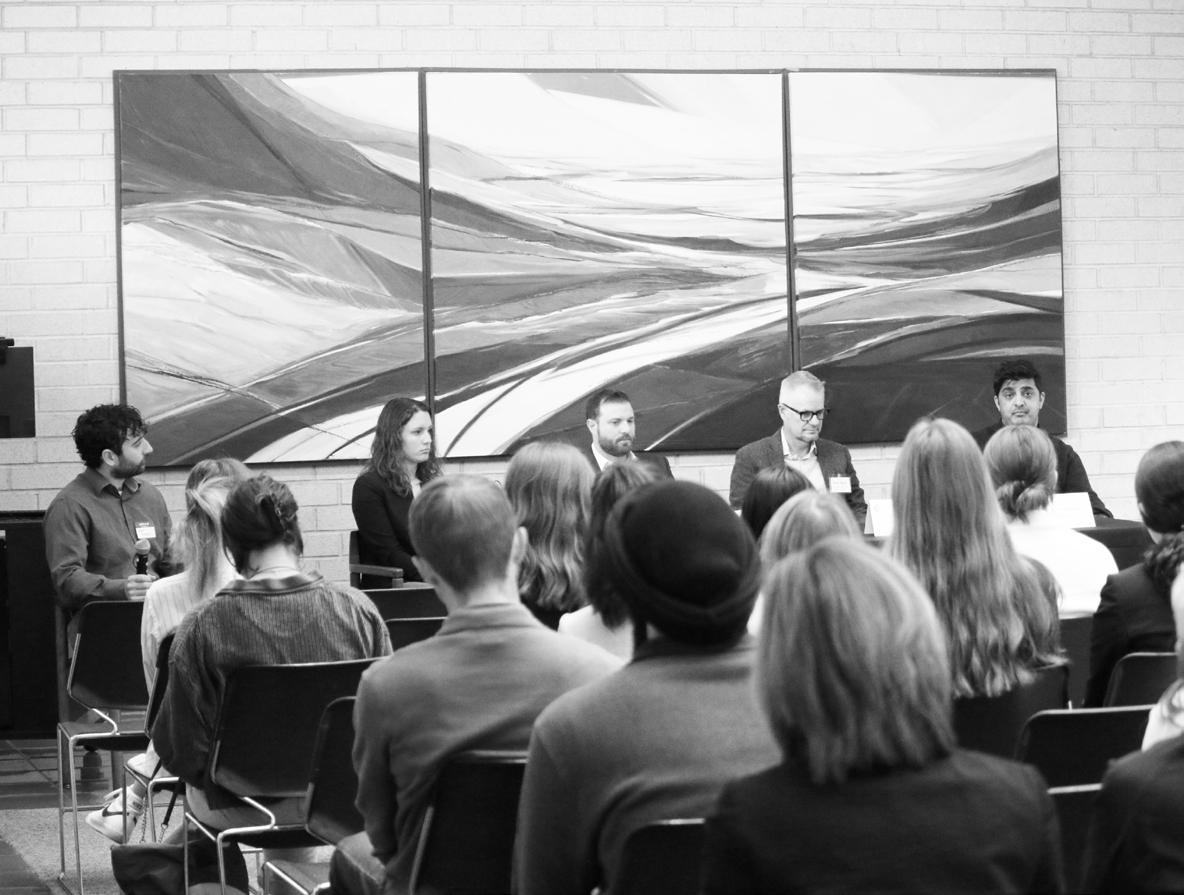
“I thought it was really insightful to have the opportunity to speak with these professionals one-onone,” Spinelli said. “[I got to] ask them specific questions about their line of work and how they got to where they are today.”
Ascher explained that the conference revealed the range and versatility of climate-related careers. Many panelists stressed that their backgrounds and paths were all quite different, but that a wide variety of careers exist that relate to the environment and conservation. As a student, Spinelli appreciated hearing insights about the panelists’ academic path toward their current careers.
“It was a really common theme amongst the panelists to talk about how their pathway to their career was not straight at all and [it] was actually very unexpected for them to end up where they did,” she said. “That gave a lot of students, myself included, the incentive to follow what we are passionate about.”
Sherrilyn Ifill and Penny
Lee Dean announced as 2023
Pomona commencement speakers
In a Jan. 31 email to the Pomona College community, President Gabi Starr announced the Commencement speakers for the Class of 2023: civil rights attorney Sherrilyn Ifill and Hall of Fame swimmer Penny Lee Dean PO ’77. The pair will receive honorary degrees and address the graduating class during the Commencement ceremony on May 14, 2023.
JUNE HSU & JAKE CHANG
As the student-led disciplinary board begins its spring semester training, Pomona College’s Judicial Council (JBoard) seeks to increase transparency and interaction with Pomona’s student body.
JBoard releases its case files semesterly, with redacted information to protect student privacy.
JBoard Chair Rya Jetha PO ’23 explained that the files are meant to inform panelists on the institutional precedent for handling certain kinds of disciplinary cases and they serve as a guide for respondents going through the process.
“For students going through the disciplinary process, the mechanics of how a hearing works, how a panel works can often be opaque,” Jetha said. “Going through the case history files is a good way to assuage those fears and see how the process works before you enter it yourself so that you’re not anxious and stressed about it.”
But despite JBoard’s existing efforts toward transparency, many students are completely unfamiliar with the council’s role in the disciplinary process. Even nearing his third year, Cole Kendrick PO ’25 shared this confusion.
“[Initially] I thought it was a group of administrators who tried to help the students be safe,” Kendrick said. “I think they try to be transparent in what they do. I know they sent emails about the student code, but [emails] get lost in the shuffle.”
The JBoard consists of four student chairs and 40 student panelists, overseen by three Student Affairs advisors. The judicial body rules over any cases relating to the Student Code of Conduct that are not under the jurisdiction of the faculty-run Student Affairs Committee or Student Code Administrators.
The student-run aspect of JBoard was designed to engage
students in the conversations surrounding penalties, providing respondents with a panel filled with peers rather than faculty and administration.
JBoard trainings educate panelists on the current practices of JBoard, which include any amendments to the student code that are passed by their parent organization, the Student Affairs Committee (SAC). JBoard panelist Alessio Gonzalez PO ’26 explained that the panelists are intended to more effectively discern student character and context of the case than faculty.
“We [the panelists] sort of gauge whether or not they feel remorseful or that they didn’t really know that the thing that they did is wrong,” Gonzalez said.
Panelist Lexy Duffy PO ’26 felt the introduction of other students to the disciplinary process has been a successful aid in supporting classmates.
“People seem almost more comfortable being able to kind of speak amidst people they see day-to-day, people that are in that community from which their actions have affected,” Duffy said.
In the event of a Pomona College Student Code violation, the details of the case are compiled into a Statement of Alleged Policy Violation. Then, the case may be delegated to JBoard.
That student is then expected to meet with a student dean assigned to the case in order to determine whether to accept or deny responsibility for the infraction. The majority of JBoard cases result in what is known as a “penalty hearing,” in which the panel decides on the course of action based on a case’s available evidence. However, there are many practices that fall outside of the JBoard’s purview.
“The council’s jurisdiction does not entail academic dishonesty, Title IX cases and drug and alcohol offenses,” Jetha said.
“Those are received by the appropriate channels, such as the academic disciplinary board and the Title IX office.”
The Judicial Council previously governed over alcohol and drug offenses but has shifted towards restorative justice practices. Instead, students will talk with an administrator for their first or second violation to connect them to rehabilitative resources, if necessary.
“We found that students don’t relapse. They usually learn from their mistakes,”Jetha said. “There’s no point in going through the entire judicial process.”
Additionally, an amnesty policy stipulates that those who report any alcohol and drug violations will not have to go through the judicial process, either.
“We realized that that was just not a restorative practice,” Jetha said. “Students make mistakes, students are learning. They’re testing their limits.”
While JBoard is a designated judicial body, many of those involved see the future of the organization as more of a reformative and healing process rather than a truly judicial or penal one.

“What you’re seeing is much less of a focus on this really strong hand coming down on a student and more so ways to reintegrate back into the community,” Duffy said.
Jetha also hopes to demystify what JBoard does and emphasizes that their doors are always open to the community.
“At least since I became chair, we’ve had a lot of outreach efforts,” Jetha said. “It is hard to conceive what the disciplinary process of JBoard is like if you haven’t been through it yourself or you’re not involved in it. So that’s a continuing thing that we do.”
American civil rights attorney Sherrilyn Ifill served as President to the National Association for the Advancement of Colored People (NAACP) Legal Defense Fund for over a decade. Through her work at the NAACP, she has been involved in addressing and influencing a host of national civil rights issues. In 2021, Ifill was recognized on Time’s annual TIME100 list as one of the most influential figures of the year.
“Sherrilyn Ifill was chosen as a compelling legal scholar and national voice for justice on issues such as police reform, voting rights, affirmative action and education,” President Starr told TSL via email.
Penny Lee Dean, an American marathon swimmer and Pomona College alumna, has broken world records for fastest swims at the Catalina Channel in 1976 and 1977 and the English Channel in 1978, setting 13 world records throughout her career. Dean was inducted into the International Swimming Hall of Fame in 1996, and began her nearly 30-year coaching career for the Pomona-Pitzer swim and water polo teams.
“Penny Lee Dean ’77 was selected as an exemplar of athletic dedication and achieve -
ment,” President Starr told TSL via email. “Not only is Dean a world-record-breaking marathon swimmer, she also coached and taught at Pomona for 26 years, making important contributions to our own community as well as the wider sports world.”
Through a lengthy group deliberation process, Ifill and Dean were chosen by a committee of trustees, faculty, students and staff. Candidates for honorary degree recipients are nominated at least two years before the Commencement ceremony by the Honorary Degrees Committee, and are then approved by the Cabinet of the faculty before finally being presented to the full Board of Trustees for approval.
Honorary degrees, according to the Pomona College guidelines, “allow Pomona College to demonstrate in a very public fashion how [Pomona] values are reflected and exemplified in the character of an individual who has made extraordinary contributions to society.”
Zaid Al Zoubi PO ’24, Associated Students of Pomona College (ASPC) Junior Class President, was involved in the selection process.
“Before [the Committee] meets, they ask us to email our classes to ask for candidates that the class finds appropriate, and then we vote in the committee together,” he said.
ASPC Senior Class President Rohan Ahammed PO ’23 said that the senior class’s unique situation regarding the COVID-19 pandemic is reflected through the resilience of the chosen speakers.
“[With] Penny Lee Dean holding so many records and being one of the first most accomplished women at the College in sports, and then Ifill also being groundbreaking in her field, I think both show tenacity in different ways, and I think that [will] resonate with my class,” Ahammed said.
PAGe 2 FebRuARY 10, 2023 New S
On February 3, 2023 Claremont College students gathered at the Roberts environmental Center to learn about careers in environmental work.
WeNDY ZHANG • THe STuDeNT LIFe
SAJAH ALI & JULIA SCHWARTZ
beLLA PeTTeNGILL • THe STuDeNT LIFe JeNNA
• THe STuDeNT LIFe
SERENA LI
MCMuRTRY
UNION: Pitzer workers allege mistreatment
Continued from page 1 former BAMCO employee Kevin Ayala was mistreated, deprived of work and denied sick time until he was eventually terminated.
At the Tuesday delegation, the three former BAMCO workers spoke to Marchant about the mistreatment they faced after expressing support for the union.
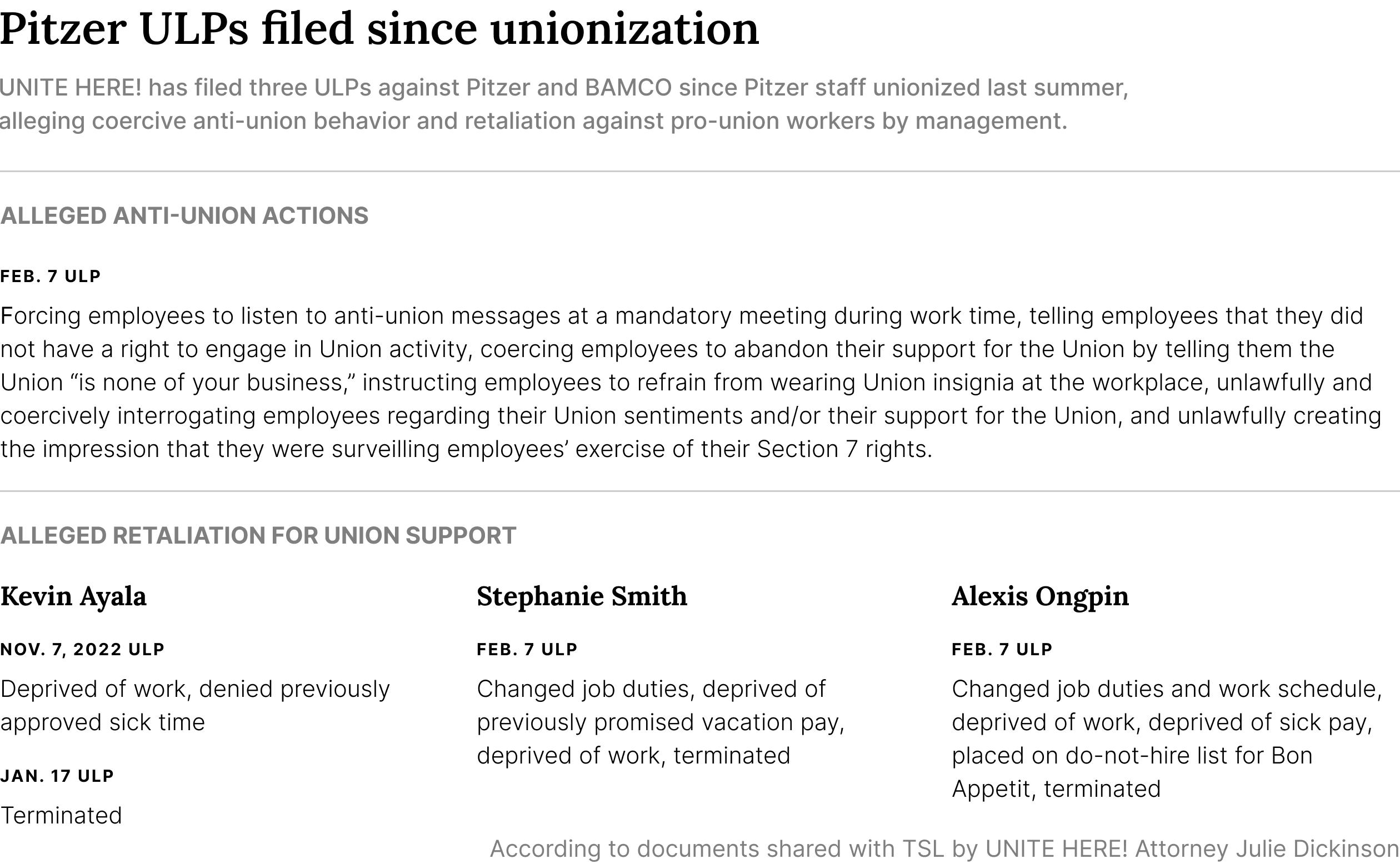
“I started wearing my [union] pin. That was the first time I noticed how my responsibilities changed,” Smith, who was discharged on Jan. 10, said during the delegation on Tuesday. “I’m not getting all the way down to cleaning counters. I’ve never done it before, I’m a caterer.”
She also said that managers told her and other BAMCO workers at a meeting that the union was “not [their] business” and to “stay away” — including at mandatory meetings during work hours, allegations which the Feb. 7 ULP reiterated.
Multiple workers expressed concerns about the behavior of General Manager Miguel Menjivar in particular, which delegation members urged administrators to address.
“He’s told [workers] false information. He’s told people they cannot be part of the Union, which is totally illegal,” Tony Hoang, a Pitzer groundskeeper, told TSL. “He does illegal thing after illegal thing, but no [administrators] discipline him.”
Both Ayala and Ongpin told Undercurrents that they were laid off before they returned to work after winter break, which Ayala attributed to their subcontracted status.
“[We] don’t have rights that workers at Pitzer have just because [we]
Corrections
work for an agency,” Ayala told Undercurrents. “It’s unfair that someone is doing the same work as an employee and isn’t getting the same pay and benefits.”
Workers told Undercurrents that the unexpected terminations have taken a toll on their lives and families. Smith said at the delegation that she takes care of three grandchildren, while Ongpin said she was forced to use her terminally ill mother’s disability money to pay for rent when she lost her job.
“[Being fired] affects my family and my mom, the person that I want to take care of,” Ongpin said. “The workers that I worked with kept a smile on my face and reminded me that there’s good things in life. For me to not be here anymore and to get treated the way that I did get treated, it’s just added some more stress in my life.”
Pitzer and BAMCO did not directly respond to TSL’s inquiries as to why the workers were fired.
At both delegations, members of the Claremont Student Workers Alliance (CSWA) and Pitzer’s Student Senate expressed their frustration with the college’s treatment of workers.
“We all thought that this community would be different. We all thought that Pitzer wouldn’t be like a big corporation that mistreats all of their workers,” said Ngaya Swai PZ ’23 at the Thursday delegation.
“These core values that all of you guys preach are lies, clearly, because the people that are actually holding true to those are the workers that you’re exploiting day in and day out.”
Pitzer Student Senate Vice President Quin Mumford PZ ’24 emphasized that students would continue attempting to hold the school accountable for its actions.
“This is unacceptable. This is illegal and extremely unethical. We will not be letting this fly,” Mumford told Marchant. “These delegations have gotten larger and larger and they will continue to get larger and larger until you fix your practice and treat our workers with respect that they deserve.”
Jacob Neville PZ ‘24 contributed reporting.
Intimidación, vigilancia y terminación ilícita: trabajadores subcontratados toman la peor parte de presuntas acciones antisindicales por parte de Pitzer.
Esta semana, más de 60 estudiantes de los Claremont Colleges, trabajadores de Pitzer y líderes sindicales se manifestaron frente a administradores y miembros de la junta directiva de Pitzer, llamando la atención a una quejas sobre prácticas ilícitas (o ULPs, por sus siglas en inglés) que el sindicato levantó contra el colegio y su servicio de cocina este martes. El sindicato alega que Pitzer violó la ley federal porque dio de alta a dos trabajadores que apoyaban al sindicato.
Para leer el resto de este artículo en español, visítanos en tsl.news/practicas-ilicitas-pitzer-2023
QUAKe: 5C students mourn collapse
Continued from page 1
struggle. “You can’t just go on with your day-to-day life,” she said. “When I’m in class and I get a notification about the 20,000 people dying in my hometown, I can’t focus on learning coding.” Alongside the feelings of stress, anxiety, and grief that have been filling her mind, Tayyar explained that she has been racked with guilt.
“We’re not [in Turkey], and not being there creates this survivor’s guilt,” she said.
Baghdadi echoed these feelings.
“Being here in class, there’s a sense of guilt that I’m attending school and living my life while my family is in the middle of Syria, in their car, fearing for their lives,” she said. Ulas Ayyilmaz PO ’24 expressed similar sentiments.
“Turkey is a community which is so intertwined,” he said. “The entire country is bleeding right now and we are all feeling responsible, we are all feeling that we need to take some action.”
While students acknowledged that the 5C community has been relatively supportive during this difficult time, they felt disappointed in the inability for their peers to relate to their experience.
“It’s really hard to share these experiences with people in the states who don’t know anything about Middle Eastern history,” Tayyar said. “I really feel like, in American media, there’s less emphasis on what’s going on in the Middle East.”
Many 5C students have expressed that this lack of understanding has made it easy for other students who aren’t part of the Turkish or Syrian communities on campus to turn their attention away from recent events.
“People must understand [that the earthquake] is not affecting one country or one nation. It is not just the problem of Turkey, it is not just the problem of Syria, it is the problem of humanity,” Kavuran said. “This is the responsibility of all humankind.” The Claremont Colleges’ Turk-
ish Student Association plans to give students an easy way to help out through a GoFundMe. According to Arpat, the money raised through this GoFundMe will go towards non profit organizations providing survivors with blankets, clothing, and other essentials.
Kavuran highlighted the urgency of donating money as soon as possible, explaining that all contributions will help provide people on the streets with aid.
“In our campaign, we’ve collected around $12,000, but that is not even equal to the number of people who died. It’s not even $1 for each life lost,” Kavuran said. “We need to do something as soon as possible, because in a month, that money will do nothing but fund graves,” he said.
Arpat also emphasized the time sensitive nature of this issue.
“Each minute that we’re not spreading the word, not trying to save lives, so many more people are dying,” she said. “I think [the earthquake] should be treated as an emergency, and every kind of resource that can be used should be provided to our community.”
While monetary donations are certainly important, there are other ways for students to show support. According to Tayyar, raising awareness about the earthquake and its effects is one of the most beneficial things that students can do during this time.
“We all have a responsibility towards each other as global citizens, and there’s always something we can do,” Tayyar said. “Speak out about it. Raise your voice about the problems in the world and show support.”
She also recognized the power of simply acknowledging Turkish and Syrian students’ pain.
“Ask us what we feel like, recognize that there is a catastrophe going on in our hometowns and that we’re very devastated,” Tayyar said. “Ask us if there’s anything you can do—oftentimes, it’s just a hug.”
Cem Öztürk PZ ’25 added to this point by stating that students need to understand that the pain Turkish and Syrian students are going through is unfathomable.
“They have to understand that they will never be able to understand our pain,” he said.
This week in history, 1983: Black students protest 5C lack of response to South African apartheid
In Issue 11, an article on the closure of the Tranquada COVID-19 testing site stated that there are five COVID-19 vending machines available for student use. The article has been updated to say there are six vending machines. TSL regrets the error. SARU POTTURI
In Feb. 2022, TSL commemorated Black History Month with “Illuminating 5C Black Legacies,” a special projects feature on Black history at the Claremont Colleges. A group of more than fifteen contributors presented a series of articles chronicling Black achievement from the turn of the twentieth century into the end of the civil rights movement.
This year, TSL’s special projects desk will continue where it left off and dive into some of the earliest celebrations of Black History Month at the 5Cs in the latter half of the twentieth century. In “This Week in History,” we bring this forty-year-old article back into the limelight (read below), along with commentary on its contents. We expand upon the sociopolitical and international issues the article mentions, contextualizing them in terms of present-day Black issues.
Cammi Lynn Cager’s article captured the candlelight march, commemorating Black History Month ’83 at the 5Cs, 40 years ago. In Feb. 1983, South Africa was still embroiled in apartheid – institutionalized racial segregation, rooted in white supremacy. The candlelight march was in direct protest to the 5C administration’s inaction and failure to explicitly support its Black students.
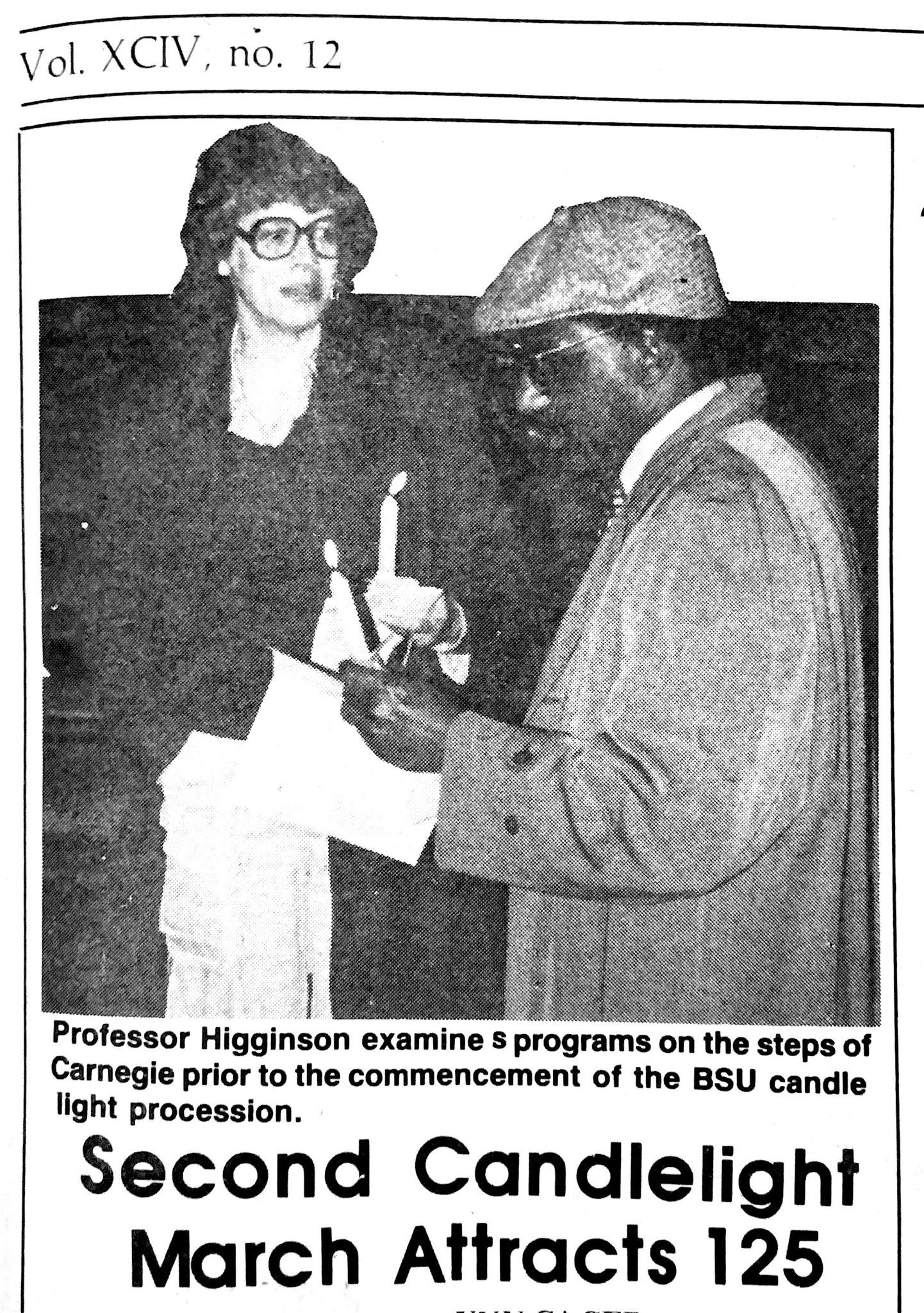
By the 1980s, the South African government had become increasingly isolated, with several other countries refusing to do business with South Africa in protest of its apartheid regime. But the US was slow to do the same. Racist or not, the South African government was putting money in the pockets of American businesses. To place trade sanctions on South Africa, then, would be detrimental to the US economy. That, apparently, was enough reason for many Americans to keep supporting the apartheid regime. But the American resistance
to the apartheid was brewing, even at the 5Cs. The speeches of then-Pomona President David Alexander and then-Pitzer President Frank Ellsworths calling for “understanding” and “cooperation” between people of different races but failing to recommend any sort of direct action. But Pomona Professor John Higginson called for direct action and encouraged 5C students to make their voices heard.
The political climate may have changed since forty years ago, and the social issues we are most concerned about may be different; but racism, white supremacy, and state-sponsored violence—the root of Black issues then and now—remain prevalent in both the United States and the rest of the world. Again, Higginson’s call to action, addressed to the candlelight marchers at the 5Cs, comes to mind; the United States government has proven time and again its disregard for Black lives, and it is only through protest and community effort that we can affect any change or reform.
Robert Cooper asked the Claremont Colleges community, this week forty years ago: if not us, who?
And if not now, when?
Second Candlelight March Attracts 125 (originally published Feb. 11, 1983)
By Cammi Lynn Cager
Despite light rain Sunday night, a sizeable group of marchers participated in the candlelight procession commemorating Black History Month. The marchers met on the steps of Carnegie at 7 p.m., followed a route leading through the five colleges and ending at the Office of Black Student Affairs. Various Claremont Colleges faculty members
speeches and the Claremont Colleges Gospel Choir
a selection of songs.
The festivities began with the group singing the Negro National Anthem “Lift Every Voice and Sing.” Robert Cooper, president of the Black Student Union, greeted the gathering marchers with an opening speech. He thanked them for coming out despite the bad weather. He later said, “I was surprised at the number of people who attended despite the rain, I’d say at least 125.”
In his opening speech he told the crowd the purpose of Black History Month is to pay tribute to the achievements Blacks have made to American society. He then challenged the gathering to work for civil justice, asking: “If not us, who? If not now, when?”
Next, President David Alexander, reminisced about last year’s procession. He said he was honored to attend and stressed the need for understanding between races.
The procession then moved to Bridges Auditorium where History Professor John Higginson, addressed the issue of “Blacks in South Africa.” He spoke of the “alliance” between America and the minority controlled governments in South Africa, which is based mainly on business interests, because South Africa is the seventh biggest foreign supporter of American businesses. Higginson went on to speculate that a war in South Africa at this time could possibly lead to a world war, especially since South Africa now has nuclear capabilities. He suggested the situation is not only the responsibility of the South Africans, but also of Americans. It is time he said for people in the United States to start taking some responsible actions, such as becoming more aware of the problem through the news media and writing to our congressmen protesting the current administration’s support
for his speech the words of Mar tin Luther King Jr. and John F. Kennedy. From King he drew the famous words: “This is a dream of a land where men of all races, of all nationalities, and of all creeds can live together as brother.” Quoting from Kennedy, he said: “We preach freedom around the world, and we mean it, and we cherish our freedom here at home; but are we to say to the world and more importantly to each other that this is a land of the free except for the Negroes; that we have no second-class citizens except Negroes, that we have no class
or caste system, no ghettoes, no master race except with respect to the Negroes?” President Ellsworth then enlarged upon these quotes to stress the need for respect and Ellsworth closed with words from Thoreau: “If you have castles in the air, your work need not be lost, that is where they should be. Now put the foundations under them.” He charged the marchers to go build them.
The procession marched to Bauer Center, where the Gospel Choir sang three selections After that it was onto the ‘mound’ at Pitzer, where the choir performed two additional numbers including, ironically, “It’s Gonna Rain.”
The participants ended at the Office of Black Student Affairs, where they took refreshments and greeted the Dean of Black Students, Denise Rayford-Hayes.
FebRuARY 10, 2023 PAGe 3 New S
gave
sang
SAMSON ZHANG • THe STuDeNT LIFe
SPeCIAL PROJeCTS PReSeNTS:
Lil Yachty’s risk pays off with new album ‘Let’s Start Here.’
Ussachevsky Festival of Electroacoustic Music blurs convention
MAYA ZHAN
Electroacoustic music seems to be an oxymoron at first glance. In the realm of acoustic music, rarely are electronics seen as more than as an additive, minorly enhancing performances after the fact. In the 31st Annual Ussachevsky Memorial Festival of Electroacoustic Music, acoustic music and electronic devices worked in tandem, enhancing each other in equal measure.
Named for seminal electronic musician Vladimir Ussachevsky PO ’35, the Ussachevsky festival was held at Pomona College in Lyman Hall as a series of two concerts on Feb. 3 and 4. The festival was coordinated by Tom Flaherty, professor of music at Pomona College. Most performers were faculty members at Pomona College, and all were prominent on the Los Angeles music scene.
stillness of her temperament; no small feat in a live setting.
Beetz started the piece physically slumped over, then as she played her flute she steadily moved into an upright position, which was then processed in the speaker as an ascending scale.
“My piece is a play on the given nature of a performing body onstage,” Beetz said. “In classical music a lot of the [performing] bodies are supposed to be still, which is an artificial construct stemming from the culture of Western classical music. If you’re in an orchestra you train yourself to play without moving, versus if you’re in a rock band you dance and move around a lot more.”
Lil Yachty, the self-described “bubblegum trap” artist has dropped a new album. The difference? This time, the bubblegum was laced with enough psychedelics to fuel Club Claremont last weekend.
But who even is Lil Yachty?
That’s a question that over the past year I’d have had four or five different answers to. A trap artist, the creator of “Lil Boat 1,” “Lil Boat 2, “Lil Boat 3.5” and a range of chart-topping singles, a successful producer — the list goes on and on. But this new album might have created his single greatest and most surprising pivot — his transition to a rockstar on his new album, “Let’s Start Here.”
If you want to get a sense of how revolutionary “Let’s Start Here.” is, listen to “Poland,” the viral hit that Yachty put out in October of 2022, before you listen to the album.
The rockstar aesthetic is not unknown in the hip-hop world — artists from Playboi Carti to Ye have attempted to make it part of their brand — but Yachty makes the musical commitment they never could through his new project, a complex and hit-packed psychedelic rock album.
“Let’s Start Here.” is at its core an inter-genre project. I’m getting hints of old and new hiphop, jazz, R&B, Motown and, at its core, psychedelic rock. The diverse influences, combined with exceptional production and creative work from Yachty and his team, create an album that is colorful, flavorful, fun, powerful and digestible. The record occupies a special niche where it can be enjoyed by rockheads and modern hip-hop audiences alike, creating opportunities for new musical dialogue. Yachty’s distinct overtuned voice and impressive range enable a project which showcases a wide range of vocal and instrumental styles. Let’s explore a few tracks, shall we?
“the BLACK seminole.” starts the album off on a strong note, opening with sexy power chords, whooshing synth lines, and of course, Yachty, who sings expressively in and around the instrumentals with his standard auto-tuned and distorted voice.
Yachty’s lyrics are familiarly braggadocious at times, referencing himself as “a sex symbol, the Black Seminole,” and at other times shockingly honest: “a Black man with mouths to feed embracing equality throughout greed.” The entire second half of the song is devoted to an extensive instrumental monologue — giving Yachty space to show off his production ability, sneak in a few more power chords and switch up the genre influences in the first two minutes.
“the ride-” sees Yachty immediately switch his tone, adopting bouncy, fluffy synths and a catchy guitar riff over his ever more expressive voice, immediately drawing attention from the listener. This song sees Yachty push his voice to its limits, layering his singing in multiple octaves simultaneously, showing us the clear contrasts in his growly detuned bass and his crooning autotuned tenor. Lyrical contrasts emerge simultaneously — Yachty expresses insecurity absent in the previous track — “when I’m alone with my thoughts I’m terrified/ that’s why I need you here by my side.” This track sees the first major feature of the album, from Teezo Touchdown. Teezo’s feature is characteristic of many on the album — he provides his own nuance to the song without overwhelming the vibe, adding just as much as is necessary and then bowing out.
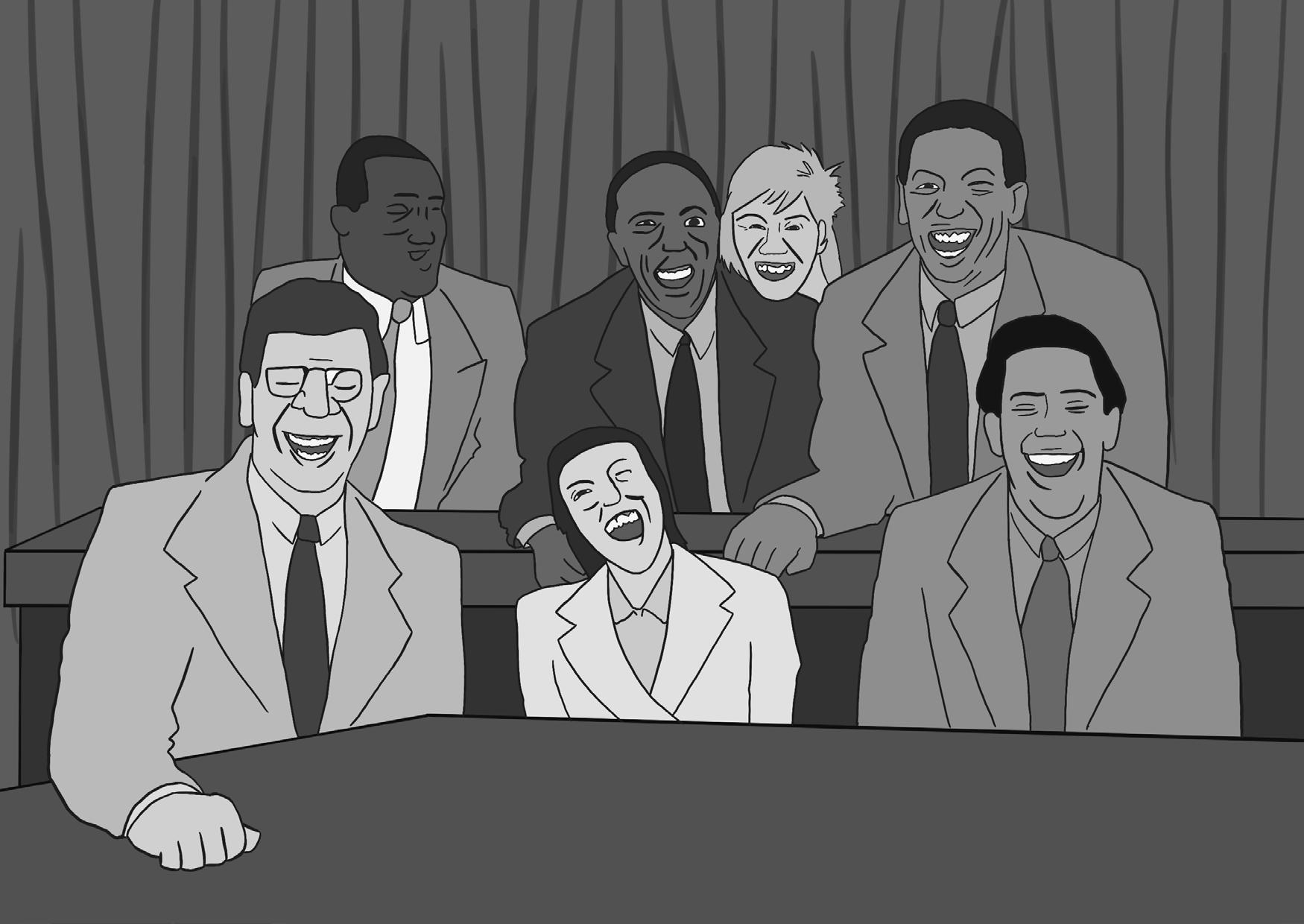
“drive ME crazy!”’ is another totally different track. It has a smooth Motown-inspired groove with a catchy bass line, a jamming drums track, fun strings and some cheesy piano for kicks. The track features an
exceptional feature from multiplatinum artist Diana Gordon, who delivers an impactful verse, smoothly romantic and desperate. Her brief duet with Yachty is reminiscent of some Jacob Collier songs, with cute ad-libs and a sing-song melody. Yachty’s lyrics are uniquely playful: “Imagine me/circling through life without a piece of you/seven out of seven days I’m needing you.” The track ends with another constant on this album — a dramatic beat shift to a moody laid-back drumdominated beat that features the closest thing to rapping Yachty does on the album.
“sAy sOMETHINg” opens with a silky-smooth synth backing track with crystal-clear drums for contrast. Yachty is as over-tuned as ever, floating on top of the beat and drifting in and out of coherence. The bars are uncharacteristically romantic and cheesy: “got me feeling like a teen again / feeling like it’s teenage love / if you feel the same way then say something.” Another beat change drives the song to bright synth chords under a crooning Yachty. “I need your love,” he calls over and over.
“Let’s Start Here.” is a revolutionary project for Yachty. It should take the artist, who has long been regarded as something of a black sheep in the rap community, to a much more recognized place in musical canon. There is an inherent risk in blending so many genres together — there are many examples of these kinds of albums flopping. But “Let’s Start Here.” serves as a great example of why musical dialogue can be so powerful — the unique intersections Yachty explores create fascinating and impactful soundscapes that make for an enjoyable and educational listen for rockheads and hip-hop fans alike.
As the name suggests, electroacoustic music is a combination of electronics and acoustics. Incorporating lavish electronic soundscapes as well as strippedback isolated instrumental lines, the featured pieces showcased the role of electronic software in inventive ways.
“The electronics make sounds that humans and acoustic instruments cannot make,” Flaherty said. “It’s as though the computer is a very flexible but unified ensemble and you can interact with it.”
Performance methods included the usage of prerecorded acoustics as accompaniment for their live playing and the employment of electronic effects as performance aids.
“Stillness is the Move,” performed and composed for solo flute by Rachel Beetz, a lecturer at Pomona College, used electronic devices as mediums for performance in themselves. The pitches of Beetz’s flute were electronically processed to parallel her bodily movement.
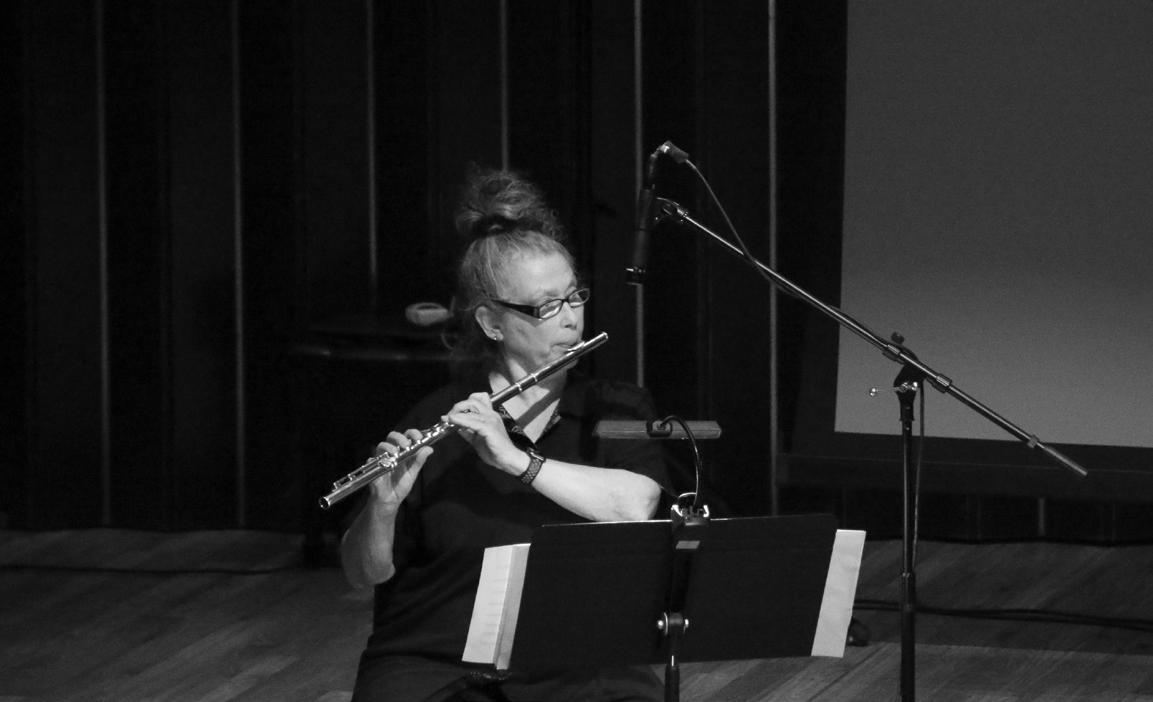
“If I move my arm down the pitch that comes out of the speaker goes lower,” Beetz said. “There’s one position in the center where the pitch stays constant and that’s where I have to play the melody. It’s about that center moment. The other things around it are an invitation to a beginning and an end.”
Much of the performance quality was contingent on the stillness of her arms and, by extension, the
JJ Hoffman PO ’26 enjoyed the piece “Nor Hope” by Wenbin Lyu, featuring vocals by soprano Melissa Givens, a professor at Pomona College. Givens sang a luminous, soaring melody overtop whispered repetition of the word “death” and a sporadic electronic soundscape, creating a sense of disquiet.
“I’m not used to this type of music, so the repetition of ‘death’ was initially a little confusing, but I felt entranced,” Hoffman said. “It felt like she was screaming in your ears — every vibration reverberated throughout the room. I felt pierced by the music.”
Regarding the avant-garde motifs, such as dissonance and atonality interspersed among the festival program, Flaherty encouraged receptivity from attendees.
“The hard thing about anything that’s new or unusual is that you’re depending on people’s openness,” Flaherty said. “We’re all open to a different degree sometimes on different days. Be open, and maybe you’ll like it and maybe you won’t. It’s a big world. You don’t have to like everything.”
“The Raven,” the closing piece by Avner Finberg, performed by violinist Sarah Thornblade and narrated by Joti Rockwell, reimagines its namesake classic poem by Edgar Allan Poe. Thornblade stepped on a foot pedal to loop and layered musical phrases instantaneously, gradually crafting an eerie sonic landscape which echoed the psychological horror of the iconic text.

The constant interplay between electronic and acoustic elements prompted a newfound appreciation for the performers’ technical and stylistic prowess from attendees, inspiring them to metacognitively re-imagine the norms of musical performance and composition.
Spirits unleashed in Zen Cho’s fantasy masterpiece
REIA LI
During one Lunar New Year celebration, my friends and I almost set a tree on fire.
That night, after eating together and reflecting on our wishes for the new year, we decided to release paper lanterns. By that time, it was late — past midnight. Had we not been so tired, perhaps we would have considered that releasing these lanterns with their open flames near a stand of trees might not have been the best idea.
We all watched with awe that quickly turned to horror as the first flickering paper lantern rose and then slowly drifted into the waiting branches of the nearest tree. By some New Year miracle, the fire did not spread to the leaves, and we watched the lantern burn out with our hearts in our throats.
The next day, when I told my father, I thought he’d laugh. Or be concerned for my safety (which he was). But the very first thing he said was, “Don’t you kids know that you’re supposed to release the lanterns on the fifteenth day of the new year and not the first? Ay, you don’t know what you’re doing — this is how traditions change.”
His words strike at the heart of a dilemma I face as a child of the Chinese diaspora. How do I engage with “traditions” when my home is an ocean or more away from their source?
These questions illuminate why I loved reading Zen Cho’s 2021 short story collection “Spirits Abroad” so much. Cho is a Malaysian writer of Chinese descent who grew up in Malaysia before moving to the UK for college, where she currently lives and works as a lawyer — her time management skills are impressive.
First released in Malaysia in 2014,
the updated “Spirits Abroad” includes nine new stories. All of the stories involve some element of fantasy or sci-fi, but what makes Cho’s work distinct is that she pulls from Malaysian and Chinese myths to re-imagine their fantastical creatures and gods spilling out into the modern day.
The stories in the book are organized into three sections, “Here,” “There” and “Elsewhere,” referring respectively to Malaysia, England and an in-between spirit world.
In each story, Cho asks: “What if?” What if a woman’s past self literally follows her around until she makes peace with her queerness — “The Perseverance of Angela’s Past Life”? What if a lion dance troupe actually helped people get rid of ghosts, as in “
起狮--行礼 (Rising Lion—The Lion Bows)”?
Or what dramatic, rom-comesque twists would occur if an orang bunian, an invisible figure from Malaysian folktales that lives in the forest, shows up to a political forum to convince his long lost love, an elderly Malaysian woman, to return to the forest with him — “First National Forum on the Position of Minorities in Malaysia”?
These questions create stories with fascinating juxtapositions and sparkling wit. But behind each “what if?”, the real question Cho is asking is about how traditions and myths meld and change as the world around us changes. How do I reconcile my family’s histories “there” with my life “here”?
Cho’s answer, it seems, is to weave Chinese, Malaysian and English into a beautiful mixture— and in doing so, she challenges the assumed whiteness of fantasy. Cho writes most of her dialogue
using Malaysian English, or Manglish, a term she’s always liked because, as she said in an interview with Locus Magazine, “it sounds like ‘mangled English.’”
For example, in “Balik Kampung,” a hungry ghost named Lydia returns to the living world during Chinese New Year to figure out how she died. She gets stuck in a traffic jam of souls leaving the netherworld and listens to another spirit discuss their plans once they get out.
“‘No lah, I’m not gonna do all this possessing stuff. Die already, no point holding grudges. I’m gonna go home, see how my relatives are doing, smell my ah
ma’s rendang,’” the spirit says.
Or, another especially poignant line comes when Lydia remembers her father arguing with her mother about paying full price for something. Her fathers asks, “‘What for heart-pain over a small thing like that?’”
This “mangled” English of Cho’s pushes back on the assumptions of how to write “good” English, and opens up a space of creative possibility for writers who feel stifled by expectations of “proper” (i.e. white, upper-middle class) English. Cho’s multiple influences also show up in her choice to write fantasy. She cites “great British fantasists like…Edith Nesbit”
as major influences in her work. However, in an essay cheekily titled “Writing My Culture For Fun and Profit,” she explained that “to write using local myths and beliefs is a form of accessing a deep truth,” a truth which she feels she couldn’t articulate if she only wrote about white people in Western settings. Cho’s writing is not about fulfilling a liberal fantasy of multiculturalism — as in, “Look! So many diverse cultures! Yay!” Rather, what is so special about her stories is the way that they challenge language and genre; Cho treats “tradition” not as a stiff box, but as fertile soil for new forms of writing to bloom. Hopefully, soon I can plant some flowers of my own.
PAGE 4 fEbruAry 10, 2023 Arts & Culture
ROWAN GRAY
QuEEr ASIAN rEADS
WENDy ZHANG • THE STuDENT LIfE
The ussachevsky festival was held at Pomona College in Lyman Hall as a series of two concerts on feb. 3 and 4.
ANDrEA
THE
rEVIEW ZONE
SASHA MATTHEWS • THE STuDENT LIfE
ZHENG • THE STuDENT LIfE PIErCED by
MuSIC
Gen Z, are we in a psychedelic renaissance or dark age?
HANNAH FRASURE
Gen Z has set off historic records for hallucinogenic use. Relevant experts attribute this popularity partly to the resurgence of scientific interest in their medicinal use, with psychedelic therapy having been successfully incorporated into treatment for an almost countless number of mental conditions. Such interest exists at the 5Cs: today, Feb. 10, there is a “Psychedelics & Neuroscience” talk by a Pomona alum who now works as a “psychedelic guide.” And last year, Claremont McKenna College had one of their alums, who now directs an entire psychedelic research center, speak about their career.
But while this resurgence has been widely heralded as a renaissance, several issues come along with the institutionalization of psychedelics, such as harm to Indigenous communities, complaints of sexual violence and the consequences of the industrialization of psychedelics.
If left unmentioned by Gen Z — especially when psychedelic use is high among our generation and the 5Cs churn out alums who go on to become psychedelic researchers — this storm halts the coming of any real renaissance. So, a psychedelic dark age may be more accurate. Or, it may be that the age never ended. These issues have existed since the first American psychedelic craze.
One TSL columnist wrote about famous intellectual Michel Foucault’s first-time acid trip in Death Valley, California (accompanied by a Claremont professor!) in 1975. Foucault was among many cultural icons to do LSD, but it is his story that is relevant to ours today.
Foucault consistently referred to the Death Valley trip as a seminal experience responsible for a political rebirth. But as this Barnard College professor specializing in continental philosophy notes, some academics criticize this rebirth for having inspired a particular cultural shift.
As explained in an article from the Guardian, “beginning in the late 60s, political change would be reframed as a struggle against oneself, against
our ‘inner enemy’. … the ‘fascist within.’”
The result, according to the authors, being that the “shift made the self just another market to conquer, with self-help coaches, new age gurus, energy healers, food counselors, alternative therapists and lifestyle brands all trying to profit off of this turn inwards.”
The Barnard professor only mentions this indictment of Foucault because he believes it places undue blame (and I agree), but the answer to the debate is irrelevant. For, the cultural shift happened regardless — at least, that is the historical stance that I have in common with the professor — and the current psychedelic renaissance must be understood within that context.
When venture capitalist firms endorse psychedelics as a “panacea” and companies advertise psychedelic use with the slogan “Cultural Awakening Through Personal Transformation,” it seems indeed the way psychedelics are marketed fits them into the politics of “therapeutic sensibility.”
Of course, just because a firm states that their goals align with the social good does not mean that the goal is insincere. But some suspicion is warranted when it comes to the booming psychedelic industry. After all, a psychedelic industry is a bit of an oxymoron when anti-capitalist fantasies were baked into the 1960s counterculture movement responsible for popularizing psychedelics in the United States.
Moreover, a group of psychiatrists detailed for the American Psychiatric Association’s news service how it is private investment, above all, that “is fueling the process of commercialization to the point that practice is leaping far ahead of research.”
And while I prefer to avoid attributing the causes of complex economic issues to singular terms (like “capitalism” or “communism”) that ignore the
wide variances in their intellectual history, I do agree in principle with Guardian columnist Belén Fernández.
“[It] is mind-bending that the very capitalist system that is responsible for generating vast alienation and mental strife should now be in the business of rectifying the situation … [it] is predicated on egregious socioeconomic inequality and the tyranny of the rich — hardly an arrangement that discourages depression and anxiety,” she writes.
Moreover, Fernández is one of several who have detailed how the extraction of resources for the pharmaceutical production of psychedelics has caused environmental and social destruction within Indigenous communities in North and South America.

But, what she did not touch on is, as what one writer describes, a “rising movement within the psychedelic community is voicing concern that the emerging industry
is poised to repeat colonial patterns that have appropriated Indigenous knowledge.”
But at the same time, despite a common narrative purported by the aforementioned psychedelic business on their “About” page — that “indigenous communities around the globe” used psychedelics for healing since ancient times — there is no empirical support that this took place on a large scale.
Anthropologist Manvir Singh writes a damning narrative for VICE Magazine how “much of what underlies it is a seductive mixture of flimsy archaeological evidence, outdated anthropological approaches and economically convenient ideology.” It is what some have called Indigenous washing — a marketing strategy, which heralds back to a hundreds-yearlong history of, as the Jim Crow Museum describes, invoking “Native associations with herbs and plants to sell medicinal
concoctions.”
There is also an oversight problem within psychedelic therapy. Many so-called psychedelic guides lack any relevant professional accreditions, which has resulted in — the words of one investigative report — allegations of sexual abuse being “not unusual within the field of psychedelic therapy, and the risks are widely known among practitioners.” In fact, an entire podcast — Cover Story from the New York Magazine — is devoted to detailing the entire, extensive history of these allegations. Sound scientific studies showing the virtues of psychedelics should not be ignored, nor should recreational users necessarily stop. However, these issues demand our full attention, as Gen Z and in Claremont, in psychedelic discourse.
Hannah Frasure PO ’24 often sits around pretending to be The Thinker is a philosophy major who began as a neuroscience major.
5C club works to make fentanyl strips and NARCAN accessible
CW: Eating disorders
On Monday, Jan. 31 from 5:306:30 p.m. at the Pitzer College Grove House, Hava Sprung PZ ’23 and Jules Schneiderman PZ ’25, wellness advocates for Pitzer Strive2Thrive, hosted a student-run mindful eating space. Created for folks to be in community with others who want to be intentional about their relationship with food, this space was open to anyone within the 5C community and all were welcome.
The program began with a safe space to relax, eat, reflect and chat with other community members in a warm setting. The Grove House’s famous cookies were provided. Then, Schneiderman led a short meditation and provided the group with a journal prompt to practice mindfulness and intentionality.
These practices were centered around self-compassion, which Schneiderman sees as crucial in fostering a healthy relationship with food. As Schneiderman points out, “if you have more self-compassion and understanding of your body, you start to treat it with a lot more respect and care.”
Although Sprung and Schneiderman founded this space, they want to emphasize that this is a space for all community members to co-create.
“Jules and I are the facilitators of this space,” said Sprung. “Yet, our intention for this is to be a community where we’re building what we need out of it… we’re building relationships, trust, and co-creating this space for everyone involved.”
“This is a space to be in a place of community for those healing or interested in fostering a mindful relationship with food,” one Pitzer sophomore and mindful eating space
member said. This community provides them with a safe space to reset their perspective on a healthy relationship with eating.
Throughout the program, Schneiderman and Sprung opened up the table for conversation and discussion — always optional — surrounding relationships with food, bodies, exercise and eating. Anyone was free at any time to step away from any conversation or discussion, no questions asked and are encouraged to do so if it makes them uncomfortable in any way.
Sprung and Schneiderman chose the Grove House as a space to hold the program.
“The Grove House feels homey, and that’s sort of something you lose when you come to college,” said Schneiderman.
In essence, Sprung and Schneiderman started this mindful eating space because it’s something that they felt was missing in the 5C community.
“Disordered relationships with food and bodies in general is something that is so pervasive and I know so many people experiencing similar things… but it just isn’t being talked about,” Sprung said.
Furthermore, Sprung mentions that eating disorders and disordered eating are “individualistic and isolating,” especially in a college context.
“A lot is going on during this college transition - leaving home for the first time, learning how to eat in dining halls, stressful schedules, new friendships, pressure from others,” said Whitney Tawney, RD, CEDRD, the Nutrition Services Specialist at the Claremont Colleges.
“All of these challenges, changes and increased stressors can often create the perfect storm, making students more susceptible to eating

disorders.”
Moving forward, those within the mindful eating community and beyond would like to see more open conversations around disordered eating and eating disorders at the 5Cs and the broader society.
“Since eating disorders are not really talked about here — or anywhere to be honest — having this group makes me hopeful that there will be a day when more attention is brought to the gravity of disordered eating and bringing it up won’t be seen as attention seeking,” said another mindful eating community member.
“It’s essential to work towards dismantling diet culture, weight stigma and fatphobia on campus,” Tawney said.
Similarly, Sprung and Schneiderman emphasize that this mindful eating space functions as a starting point towards shifting notions of diet culture and open discussions around disordered eating.
“Eating disorders or disordered eating, or just issues with food in general are so prevalent, especially on college campuses, that it seems like such a great place to start creating a community around eating so that people feel more included and can have a community of support in healing processes “ said Schneiderman.
The Mindful Eating Community Space meets from 5:30 to 6:30 p.m. on Mondays at the Pitzer College Grove House.
If you feel like you may be struggling with an eating disorder or disordered eating you can make an appointment with Whitney Tawney by calling Student Health Services at 909-621-8222. You can also reach me at whitneyt@ claremont.edu.
In an attempt to reduce fentanyl-related incidents and overdoses, the Emergency Medical Services (EMS) club and the End Overdose organization are working with college student bodies and organizations at the Claremont Colleges to make fentanyl strips and NARCAN accessible to students across the 5Cs.

Fentanyl strips detect the presence of fentanyl in different types of drugs and are proven to be 96100 percent effective by the Johns Hopkins Bloomberg School of Public Health. NARCAN is used to treat potential opioid overdoses in emergency situations.
The EMS club started this initiative because of how commonplace fentanyl overdoses are, especially since the drug is often laced in other drugs. This is particularly a problem in California, where in 2021 there were 6,843 opioid-related deaths, 5,722 of which were fentanyl-related according to the California Department of Public Health.
“What we’ve seen on campus is that a lot of people or at least some of the people that we even know have overdosed on drugs and so we wanted to make sure that everyone’s getting the help that they need,” said Rohun Krishnan PO ’24, the co-vice-president of the club.
After they decided to make a conscious effort to reduce fentanyl overdoses, Krishnan and his co-vice-president, Reece Ger PO ’24, reached out to other clubs around campus to collaborate. They received their biggest support from End Overdose, an organization that works to provide students with the resources to end drug-related overdoses through education, intervention and awareness. End Overdose has distributed 62,190 teststrips and 18,490 NARCAN Kits across the country since its founding.
The EMS club received theirs free of charge.
Ember Yanez PO ’26, who is currently implementing a chapter of End Overdose at the Claremont Colleges, said that the program decided to work with the EMS club to reach their ultimate goal of preventing drug related deaths.
“By working with large clubs and programs at different colleges and high schools, End Overdose can make large steps towards this goal,” Yanez said. “Since the EMS club has such a strong presence on campus, collaborating with them allows End Overdose to maximize its outreach.
Currently, Yanez is working with the EMS club to help them become trainers in NARCAN and helping with events and fundraising for this initiative.
While the use of these products has been approved, both clubs are still working to make the products easily accessible to students throughout the 5Cs. Krishnan hopes that the fentanyl strips will be available in residence halls, although this has not been approved yet.
“We want to be able to put them inside of each residence hall so that people can go and just access them without having any pressure of being labeled,” Krishnan said.
The club also plans to have training sessions so that even more students are equipped to use NARCAN.
“NARCAN costs about $300 a dose, so they have very stringent protocols and training sessions, so we’re gonna get trained as teachers for this program and then we’ll host sessions where we can train anybody and everybody who’s interested and at the end of that session, they’ll get a dose of Narcan,” Ger said.
Yanez says that these training sessions will also educate people about why reducing drug-related deaths is so important. “These trainings will also involve general education about the drug overdose death epidemic in our country and why harm reduction is a necessary part of solving this problem,” Yanez said.
fEbruAry 10, 2023 PAGE 5 Arts & Culture
EMMA NEWMAN
NEurONAL NEWS
ANDrEA ZHENG • THE STuDENT LIfE
Pitzer mindful eating space offers support for those seeking a healthy relationship with food
JULIA SKAGGS
JOANNE OH • THE STuDENT LIfE
COurTESy: TIMA MIrOSHNICHENKO/PEXELS Emergency Medical Services (EMS) club and the End Overdose organization are working to make fentanyl strips and NArCAN accessible to students across the 5Cs.
LA-based artist Phung Hyunh shares her story on the effect of western beauty standards on the Asian American community
CARTER SOE
Everyone has a story to share. Phung Hyunh, a Los Angeles-based artist and educator who has exhibited her works internationally as well as completing public art commissions across Los Angeles County, came to Scripps College to share hers.

Hyunh reflected on how her experience as a Southeast Asian refugee of Cambodian, Vietnamese and Chinese ancestry coalesces with western beauty standards, whitewashing her cultural and racial identity. On Feb. 2 at the Humanities Auditorium at Scripps, Hyunh displayed her fascinating artwork that deeply informs her Asian American identity as well as the experiences she faced as an immigrant in the United States.
After migrating to the United States from Vietnam at the age of eight, Hyunh was surrounded by multicultural practices and languages growing up. Her diverse background influenced her artwork as she attended Art Center College of Design in Pasadena and continued her studies at New
York University. From there, she has served as Chair of the Public Art Commission for the city of South Pasadena, as well as being a recipient of the City of Los Angeles Individual Artist Fellowship. Her artwork is currently represented by the Luis De Jesus Gallery in Los Angeles.
“White is right, white is pretty,’’ is what Hyunh was told growing up. This idea of Asian women conforming to Western beauty standards such as pale skin and double eyelids is what sparked her art collection, “Pretty Hurts.”
While displaying her art piece titled “Nose-Sharpener” from a projector for the audience to see, Hyunh explained its inspiration.
“I am interested in how contemporary plastic surgery on Asian women have not only obscured racial identity, but how it has also amplified the exoticism and Orientalist eroticism of Asian women,” she said.
Hyunh referenced a tool called the nose-sharpener, which was specifically marketed towards Asians to sharpen their nose
bridges. Inspired by this object, Hyunh painted a portrait of a woman with prominent Asian features sitting in a feminine position, smoking a cigarette with one hand while using the other to sharpen her nose. Her small feet are bounded, one of the earliest forms of plastic surgery which contrasts with the Western beauty that the woman is trying to achieve.
Hyunh wanted to create a collection in an “Asian style” artwork but display the gruesome process of what Asian women go through to appeal to Western beauty standards. Her other collection, “Donut (W)hole,” shares the story of several Khmer kids who grew up in mom-and-pop donut shops across the United States. Dubbed the “Donut Kids,” Hyunh drew these first and second generation “Khmericans” as cartoon figures on pink silkscreen paper with actual pictures of their donut shop as a backdrop, creating a “before and after” layering effect. The pink symbolizes the copious amounts of pink donut boxes that were sold throughout their time at the shop.
“These donut shops represent a cultural space where refugees and immigrants reshape their lives in the process of negotiating, assimilating, and becoming American,” Hyunh said. The stories of being taken to the shops at 3:00 a.m. and sleeping on top of flour bags to coming back after school to do homework are all prevalent in these paintings.
Kirby Lam PO ‘23 was one of the several attendees who was touched by Hyunh’s paintings.
“It was a cool representation of the ways that their family background, as influenced by genocide, war and the American immigrant struggle, shaped their lives as adults.” Lam said. “Like Phung, I’m also Southeast Asian with family that emigrated from Southern China through Cambodia and Vietnam. While I haven’t really negotiated my Khmer American identity too much yet, it helped me think about how my life has also been shaped by this legacy of displacement and hope.”
Martha Gonzalez, professor of Chicanx-Latinx Studies at Scripps College was one of the
organizers for this event. As an artist herself whose focus is on music through a social justice lens, Professor Gonzalez strives to bring other artists who also share a passion for raising minority representation in their fields and communities into this movement.
“Phung Hyunh is a very notable artist, and I know that her work is not only reaching across other communities in color but also empowering her own community as well,” says Gonzalez. “Art can really perpetuate this kind of dialogue. The kind where people can talk, cry and are moved by the experience. That’s exactly what I want.”
It’s artists like Phung Hyunh who share their stories that allow people from various communities to come together. To bring people from all different backgrounds and talk about these experiences while inspiring those to start participating in art.
“It is more than just donuts and pink boxes,” Hyunh said. “It is about being able to tell our own stories before they are told for us. It is about sharing our humanity when we are veiled by inhumanity.
The screenlife genre and connection in the internet age
In a world dominated by digital echo chambers, misinformation and the looming fear that algorithms are spying on users, the technological discourse has inevitably become paranoiafilled. The concept of the cloud has grown more prevalent over time, motivating users to maintain privacy by creating pseudo-identities, otherwise known as profiles. To hide their real identities, many users cover their webcams out of a fear that someone is watching their every move.
In recent years, the screenlife film genre has translated these anxiety-ridden aspects of scrolling onto the big screen. Emerging as an offshoot of found-footage horror, GQ Magazine defines screenlife as an exploration of “how our digital personas differ from who we are offscreen, [and] the ways casual cruelty can be enabled through the distance created by posts and avatars.”
Although films about the internet have existed for as long as the internet itself, what is special about screenlife is its use of exclusively on-screen storytelling. This method binds the skepticism that digital natives have towards films that depict the idiosyncrasies of internet communication, as many of them seem outdated or miss the mark entirely.
These films create a plot in which the protagonists depend on their devices, making the desktop landscapes feel authentic and lived-in. From its depiction of individual texting styles to tab minimizations, screenlife gets the details right while offering a larger commentary on the relationship between people and the technologies they use.
From the hesitancy before a text is sent to the way people use the
same password for all of their accounts, screenlife is able to capitalize on the minute details of internet linguistics. Though characters in this genre are often put in extreme situations, there is a universal element to the way users disconnect from their real lives when a screen is in front of them.
The most successful entries to the screenlife genre have been the films “Searching,” “Profile,” and this year’s “Missing.” “Missing” serves as a “spiritual sequel” to 2018’s “Searching,” as both films are thrillers where the main character attempts to find a recently missing family member through the internet. Think
“Finding Nemo,” but instead of Marlin traversing the ocean to find his son, he goes through a sea of archived internet accounts and emails.
On paper, this genre may seem like a snooze. Why would audiences want to watch other people browse the internet, especially if they themselves are browsing it every day? However, the appeal of “Screenlife’’ is not the fact that these characters are on the internet, but it’s how they use it to understand, and to an extent, discover, the people in their real lives. In both “Searching” and “Missing,” the protagonists investigate the whereabouts of
their missing relatives while an ongoing investigation is occurring in the background.
These parallel streams of inperson and online searches create a tension between the boundaries of privacy and revealing the true nature of a person or situation.
“Profile,” another screenlife film, is able to tackle the tension between privacy and truth headon, making the case that their interplay is at the heart of human interaction. The protagonist is deceived within an information echo chamber, and the film clearly makes the case that this deception could have occurred in real-life as well.
Beyond these examples, the
screenlife genre aims to articulate how the internet informs personal relationships and dynamics. Social connection is always characterized by information that is left unsaid, as people drown in an awareness of their own assumptions and preconceived notions –– the digital screen doesn’t create this tendency but simply maximizes it. These films serve as a reminder of how people connect both off and online, creating perceptions based on what they choose to show each other.
The chaos that ensues in all three of these films is beautifully communicated through the online setting. From embedding soundtracks within the music apps on a desktop to highlighting the sneaky shortcuts we use to seek or hide information, these films tell us a whole lot about how we navigate relationships in a time when screens dominate.
In an age when polarization, selfexpression and surveillance define much of technological discourse, screenlife introduces a new way for people to examine the reallife implications of these topics. Instead of capitalizing on the fear that someone is behind a user’s webcam, the genre dissects why that fear exists in the first place.
Screenlife calls out the tensions and hypocrisies of online users to the users themselves. It takes a crack at several important questions: If people are so scared of being watched, why are they constantly watching others? Should users be able to invade other people’s privacy in pursuit of some greater understanding? Even though this genre may not offer direct answers to these questions, it can help uncover a semblance of the truth while accepting a fundamental reality — the internet is only getting bigger, and users must figure out how to consume it without letting it be all-consuming.

PAGE 6 fEbruAry 10, 2023 Arts & Culture
PETER DIEN
bEHIND THE SCrEEN
LuCIA MArQuEZ-uPPMAN • THE STuDENT LIfE
CArTEr SOE • THE STuDENT LIfE
Phung Hyunh, a Los Angeles-based artist and educator who has exhibited her works internationally as well as completing public art commissions across Los Angeles County, came to Scripps College to share her story.
stop beating around the bush
aggressive? Should I do circles around the outside of their lips? No, that’s weird. Is it okay if I put my tongue inside? But guess what? Practice made perfect or maybe close. Perhaps, you googled some of the answers and the back of your pillow might have helped too. But it took effort and a willingness to try, because you hoped that someday you might please your partner and that outweighed your embarrassment. That shouldn’t go away just because you’ve gone to fourth base a few times. Embrace your learning curve. The best students are the ones who study.
CMC, it’s time to renounce the Claremont Institute
ROWAN GRAY
This Valentine’s Day, some of you may be giving out chocolates or flowers, but I’m giving out condolences — condolences to all the people with vaginas that won’t get eaten out next week.

I’m not going to beat around the bush (pun intended). Welcome to college! Your classmates are having sex. You might be too. If you are, congratulations. But here’s your first lesson on how to be an adult: sex is about taking and giving pleasure.
And quite frankly, I’m sick of hearing people on this campus complaining about how their straight, cisgender, male, sexual partners forget to go down on them, or even worse – simply refuse.
Before I continue, yes, I’m aware that I’m solely blaming straight men for this problem. But in my experience, this issue of completely bypassing the box has been predominantly heteronormative. I’ll be honest, my queer friends just haven’t had the same problem. Forgive me.
Rather, I’ve found that this epidemic of oral neglect for the vagina is rampant amongst the 5C hook up culture. I’ve been intent to find out why. I’m a serious journalist after all. The arguments I’ve heard are as follows:
First, disgust. “I could never go down on a girl, what if it smells bad?” “That’s nasty. It bleeds down there.” “Vaginas freak me out. They’re gross, dude.” Now, I’m not saying this in jest. I’m serious. These are real comments I’ve heard on campus of folks ready to projectile vomit all because a life-giving organ was brought up. So, let’s discuss.
The fear mongering hygiene taboo that the protected, self-cleaning
TuNNeLS
genitalia is somehow filthier than the rest of your body that is readily exposed to the outside debris, odor, and germs on a daily basis is absurd. If there were a genitalia competition for cleanliness, are we really suggesting that the penis — concerning which, a reported 60% of men wash incorrectly — is the cleaner alternative?
For decades we’ve taught women they need to chug pineapple juice, spray perfume in their panties and even shoot some strange concoction of water, vinegar, baking soda, and iodine up their vaginal canal in order to “douche” away the stench, yet to suggest anything more than a shower to clean your body would be considered neurotic.
When we grow up, sometimes, we find out secrets. Here’s one.
Santa Claus isn’t real. Here’s another. Vaginas don’t smell like fresh petunias and chamomile oil. They smell like skin and the human body because they’re a natural part of it, and just like all natural parts, they can bleed.
Second, fear. I’ve found this is most commonly the underlying emotion behind disgust. The kitty has mystified the masses, and many men simply don’t know how to approach it. And to that, I begin to feel pity. But not that much.

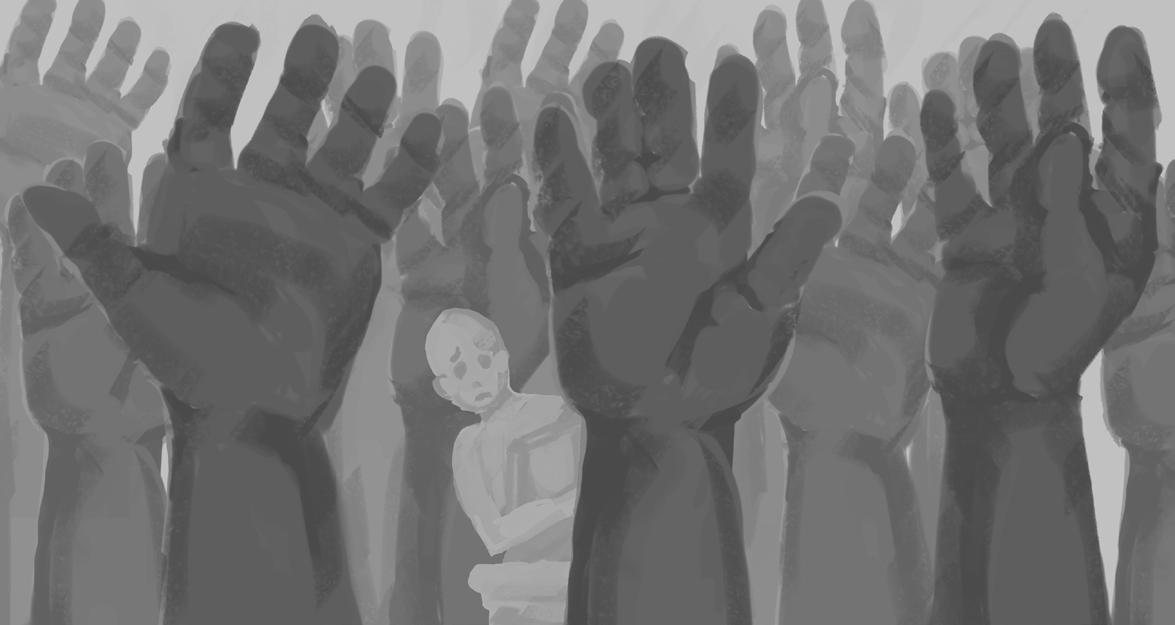
I used “kitty” for a reason. The vagina is not a dog, and it won’t bite you. For anyone engaging in sexual activity, there had to be a first. Perhaps, it all started with a kiss.
As an insecure, inexperienced young person, it was likely terrifying to lean into another person and fumble your tongue awkwardly around their lips. Where does it go? Am I too stiff? Too
BY BELLA PETTENGILL
Someone might object here that it’s not sex positive to shame others for being afraid or unwilling to do a certain sexual act, including oral sex. And to that, I only ask: is it mutual? If you and your sexual partner have both agreed that you are uncomfortable performing oral sex on the other for whatever reason, that is your business and outside of the scope of this problem. And of course then, the vaginal partner likely wouldn’t be complaining in the first place.
But specifically for those sexual encounters, where beyond all good reason, it’s permissible and even expected to satisfy the penis and not concern themselves with the vagina, that brings us to the third objection.

Third, and what I believe to be the true reason behind it all, contempt. You guessed it. This article is highly feminist, and I believe the stench of patriarchy permeates everything, even your bedroom. Sue me.
Cutting cunnilingus from your sexual routine is inherently patriarchal. It minimizes the vagina as a sexual organ and one worthy of individual attention. Instead, it reinforces the idea that women and everyone with a vagina cannot and should not be sexual creatures who deserve pleasure too. They are treated as a sexual object whose sole purpose is to serve the penis. The other partner’s happiness is an afterthought. In turn, the penis remains at the top of the psychosexual hierarchy.
There’s a reason sex is linguistically distinguished from masturbation. Sex is a collaboration between individuals. Sex is cooperative. Sex isn’t selfish. You shouldn’t be either.
Averi Sullivan PO ’23 is a passionate vagina rights activist and loves a good hot take. She wants everyone reading this to submit their hot takes to editor@tsl.news. Right now.
Here’s a joke for you, dear TSL reader: What do you get when you cross a Reagan-era conservative think tank with neo-fascist conspiracy theorists and homophobic lawyers? The Claremont Institute! What’s that? You’ve never heard of the Claremont Institute? Well, you’re not alone — of all of my hundreds of friends I talked to while writing this article, only a few had. So, what is the Claremont Institute? Why should you care about it? What do they have to do with us? And what should we do about it?
The Claremont Institute is a hugely influential conservative think tank. They are known for providing the most widely-used ‘intellectual’ justifications for Trumpism. They have influence over powerful conservative figures including Ron DeSantis, Tom Cotton, Clarence Thomas, Christopher Rufo (the inventor of the Critical Race Theory panic), and of course Donald Trump himself. In other words, the Claremont Institute is an immensely impactful political organization.
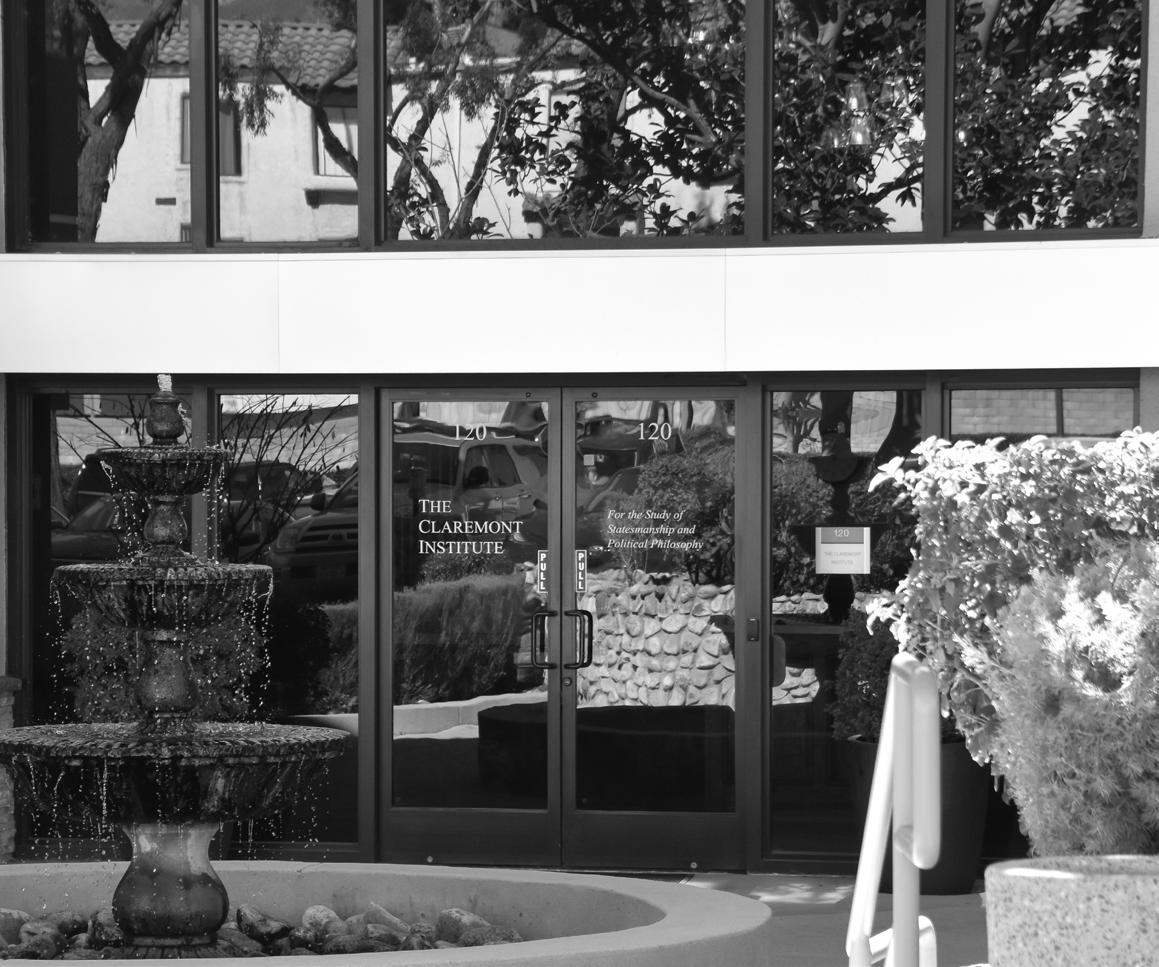
The best way for me to communicate the nature of the Institute is to offer a few examples of the people they associate with. John Eastman, the lawyer behind the theory that Mike Pence could overturn the 2020 election, is a senior fellow at the Institute, and was supported by them both before and after January 6th. Eastman also famously fought against the legalization of gay marriage. Jack Posobiec, the man behind the ‘Pizzagate’ conspiracy theory that asserted that Hillary Clinton and other top Democratic officials ran a child sex trafficking ring out of a D.C. pizzaria, is involved with the institute, as is The ‘Raw Egg Nationalist’, an internet persona known for his affiliation to the neo-Nazi group ‘Antelope Hill Publishing’. The Institute is also, somewhat unsurprisingly, quite the boys club — only 3 out of their 43 fellows are women, and none of them are senior fellows.
What might say even more about the Claremont Institute than the individuals it platforms are the beliefs expressed in its name. There have been countless articles published waging war on queer teachers and gay boy scout leaders, arguing against democracy, and
supporting conversion therapy. Their mission, as stated by their president Ryan Williams, is to ‘defend Western Civilization’ — a transparent dog whistle.
More importantly than how powerful or disgusting they are, you should care about the Claremont Institute because it is associated with you. Although all 7Cs maintain that they have no ties to the Institute, the Claremont Colleges are not widely known outside of California and, to many Americans, the striking name resemblance can be confusing. Even a TSL article about the Institute made sure to connect Claremont McKenna College and Claremont Graduate University to the institute — noting that the institute was founded by CMC faculty.
However, there are still connections that remain between the Institute and the 7Cs, specifically with CMC. Three CMC government professors, Joseph M. Bessette, Mark Blitz, and Charles Kesler continue to work at the institute. Professors Bessette and Blitz are fellows, and Professor Kesler is a senior fellow.
This connection of a think tank to a school is not uncommon — many think tanks are started by professors who work together. But the Claremont Institute is not a normal think tank: their values and platformed beliefs are extremely far outside of anything any of the 7Cs seek to associate themselves with. A quick browse through the stated values of the colleges reveals words like ‘civil discourse, inclusivity, sustainability, community, social responsibility, and impact’. The Institute does not reflect a single core value of any of the schools and is not representative, in any way, of any significant philosophical movement among the faculty, administration, or student body of any of the colleges.
As a set of small schools we must acknowledge that our small reputation risks association with bad actors such as the Claremont Institute. Combatting that association cannot be a passive process — it requires active combat against the Institution. My proposal? We should demand that the colleges, especially CMC, openly renounce the institute for what it is: an organization that platforms intellectual movements that oppose everything we stand for.
Rowan Gray CM ’26 is from Sharon, Massachusetts. He wants you to know that all Oxford commas in this piece were violently deleted by his copy editors.
First Love/Late Spring
Participation grades should extend beyond speaking in class
The archaic participation grade: a borderline sadistic, arbitrary grading component designed exclusively for extroverted speed-processors — and everyone else, well, you can have fun failing it!
The purpose of participation is for a student to meaningfully engage with class material to better comprehend what is being presented. For many instructors and students, the standard for that participation is speaking up in class.
But being vocal in class doesn’t prove you’re engaged with the material. Instead, it punishes students that don’t lean into it and ignores your actual strengths.
It’s simple. Participation standards reward extroverts because classrooms across the United States find that to be a more desirable, adult trait than being introverted.
Introverted students, on the other hand, inevitably decline into impostor syndrome and feelings of inadequacy. Not to mention, the participation grade is frustratingly American. It alienates international students who come from cultures that do not encourage students speaking spontaneously, questioning teachers’ thoughts or publicly debating with peers. These students, along with introverted students, still share the
common desire to meaningfully engage with the class material. Verbal participation standards are robbing them of this experience in broad daylight.
For many students, attentively taking notes on the material, responding to material through writing an online post, or taking extra time outside of class to process material may prove to be more beneficial for learning comprehension than attempting to be vocal in the room.
Ironically, the institutional pressure to speak in order to demonstrate participation may culminate in unnecessary stress and the formulation of rushed thoughts that do not actually result in a meaningful contribution. Being asked to add insights or comments spontaneously while attempting to process material may detract from learning comprehension.
If we’re all here to learn, then introverted students shouldn’t feel ashamed about opting out of contributing to the class discussion if it isn’t going to benefit their comprehension of the material in the way it does for extroverted students — so why do they?
a stronger foundation of knowledge than those who choose not to speak.
Not every comment or insight contributed in class discussions is substantive or demonstrates a person’s evidence of learning. From what I’ve seen, people sometimes exploit the participation grade to compensate for not performing as well on other class components, such as daily homework, essays or assessments. Since participation often takes up a larger chunk of students’ overall grade than other standalone class components, extroverted students’ grades are boosted — introverted students are penalized. Meanwhile, if someone chooses not to share their thoughts in class, they are deemed as uninterested or confused. That’s atrociously unfair. Let’s face it: students whose brains are better wired for non-vocal forms of participation are at a grading disadvantage from the start. Even if an introverted student is demonstrating their participation in non-vocal ways and is performing well on tests, essays or projects, the extroverted student will still earn a higher grade than them because of their frequent contributions. Sure, we’re “all here to learn” — but we won’t be equally rewarded for it.


That’s the message the participation grade perpetuates.
I still believe that participation should continue to be a significant part of a student’s grade, but the 5Cs need to set an example by broadening the definition of participation to include all learners.
It will create the more well-rounded grading process that the institutions set out to create. Being vocal in class doesn’t prove anything. The main goal of educators should be to establish classrooms as places that support all students. As such, educators should reimagine their grading policies. After all, there are still a myriad of ways for students to demonstrate their class material engagement,
whether it be speaking up in class, responding to material in written form or demonstrating commitment to course subjects outside of the classroom.
Educators need to acknowledge that there is not one prototype for students nor a most desirable one. All students connect with information in different ways that equally enhance our learning experience. No method of participation is either more effective, insightful or better than another. It’s about time we recalibrate the scale.
Tess McHugh PO ’25 is from Denver, Colorado. She loves eating Trader Joe’s Chocolate Peanut Butter Cups, watching The White Lotus and spending time with her cat named Chili.
February 10, 2023 PaGe 7 Opini O ns
Current participation standards assume that those who don’t speak up have nothing to say. Just because some students talk frequently doesn’t mean they have
eLLa LeHaVI • THe STuDeNT LIFe
TESS MCHUGH
aNNa SHObe • THe STuDeNT LIFe
uNDer CLareMONT: A COMIC
AVERI SULLIVAN
eLLa LeHaVI • THe STuDeNT LIFe
ever heard of the Claremont Institute? They’re an uber-conservative alt-right think tank that has provided the most widely-cited, intellectual framework for Trumpsim – and they’re sitting right in our backyard.
When comedian Mo Amer took the stage, he left me sick to my stomach
Last week, I watched students, community members and professors around me settle into their seats in the Garrison Theatre at the sold out, first-part comedy series held by Scripps Presents, “Laughing Matters! Featuring Mo Amer.”
But within Amer’s first joke, I realized he was the comedian, and my Blackness was the punchline.
Mo Amer is a Palestinian refugee. His recent fame offers more representation for a community of people that have yet to be seen on TV with a positive narrative, while simultaneously making people laugh with his standup comedy.
The 5C community had the chance to see his standup in action, and it left many in the audience laughing until the point of tears. But by the time I left his set, I wasn’t laughing. I was just angry and confused. Why?
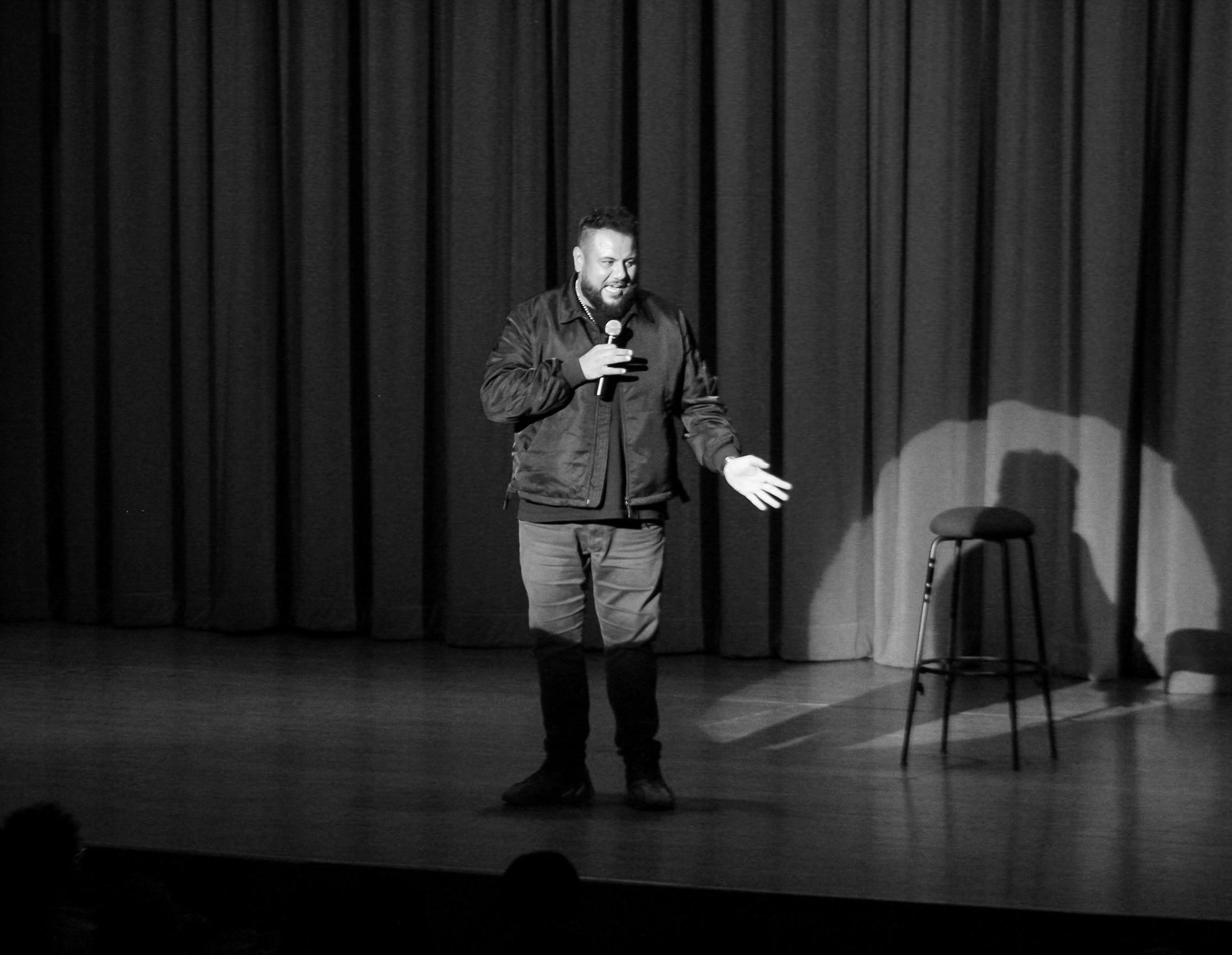
Well, it started with a story about a time Amer was selling American flags after Sept. 11, 2001. The joke was building as flags were being distributed, and suddenly Amer took a moment to address the audience. He asked if the Garrison stage was a “safe space.” My stomach dropped.
After an initial, questionable, communal “yeah!”Amer asked for a more enthusiastic response, and the audience felt obliged: “YEAH!”
I was on the edge of my seat and was fearing the worst.
The story continued. Sprinkling in little hints describing how racism is deeply embedded in American culture, Amer said the one word that no “safe space” ever deems as okay: the N-word.
Amer said the slur quickly. The room fell silent. It was a shock to everyone in the audience, but Amer moved on with the joke. He brushed past it and claimed he was using someone else’s words. But he still said it.
So why did it leave me utterly shocked, uncomfortable and scared?
As a young Black woman, hearing the slur took me out of the show. That moment immediately
brought me back over 400 years to when my ancestors had heard that word in the past and back to the reasons why non-black people said the slur in the first place.
The Washington Post described that, “At its core, the word has always been about power: the power whites held over blacks for centuries.”
Beginning in 1619, when the first slave ship met American land, the N-word was used to insult and berate black bodies while they were enslaved. It was used to describe black people as less than human — bodies to be bought and sold. With all of this history, it makes sense why hearing this word in what was supposed to be a comedy show caused my shock and fear. He was telling a mediocre joke, while I was reliving over 400 years of Black trauma.
A safe space for Amer didn’t mean a safe space for everyone. It meant freedom to say cruel, dehumanizing words without repercussions. It meant Amer covertly asking for a N-word pass with the disguise of a “safe space,” on stages across the globe.
Amer and many other comedians walk a fine line between telling jokes about race and telling racist jokes. Comedians are known for pushing societal boundaries through their comedy, but there are some lines that should never be crossed. Why?
Because those jokes aren’t humorous. They’re hurtful.
Comedians have a responsibility to their audience to cultivate a space of humor, but the experience of real people needs to be prioritized, especially those of marginalized groups. When their jokes include racist slurs or reflect ignorance and cruelty like Amer’s, they invite others to do the same — and comedians need to be held accountable.
It’s true that Amer’s actions don’t erase the fact he is paving the way for unprecedented representation in Hollywood of Arab American and Palestinian voices. This is not an easy feat.
The beauty of cyclical small talk
Prior to Amer’s arrival on campus, Pomona College Professor of Anthropology and Middle Eastern Studies Joanne Nucho and Scripps College Professor Lara Deeb were especially excited to host him.
“I think it’s also a really important thing for Arab Americans to have positive representations countering decades of really terrible depictions in the media,” Nucho said.
Initially, Amer’s show and Hollywood presence has been this counter. Following 9/11, rising xenophobia and hatred of Arab and/or Muslim Americans created a myriad of Hollywood portrayals that paint these Americans as villains.
Deeb explained that as an Arab American, “I grew up with either complete lack of representation or only negative representation.
Any positive representation could begin to break down these decade-long stereotypes, and the release of his show on Netflix, “Mo,” has created a spotlight for stories of generational trauma from those seeking asylum in the United States. I still believe his story is valuable, and Scripps’ decision to host his experience is, hopefully, a promising hint to a future of more representation on campuses.
The issue, rather, is that Amer is completely misusing his platform. Through his show and standup, Amer has created a big following and is a role model to many. As somebody masses of Americans admire, Amer has the opportunity to harness his power to influence and help finally change the narrative — but he’s failing to see the big picture. If he continues his set as is, he will begin to normalize the cruelty that these “jokes” cause.
Jada Shavers SC ‘26 is a first-year at Scripps College.
Arriving back to Claremont went like this: first we talked about winter break; then we focused on schedules; when we settled, we glorified the weekends. “Yes, January flew by, but just you wait for spring break!” There’s a seasonal clockwork to small talk – and its a wonder to behold.
Truthfully, these repetitive cycles of small talk are just another part of having a calendar that cranks out graduates every year. Talk lurches forward and loops right back again six months later.
We can be sure that the social thrill or end of semester angst of registration awaits us every few months. It will happen exactly like it always does. It’s not that your registration time is actually “horrid” and “everyone else got into better courses!”
You see, it’s this regularity of conversation that actually helps build community. It’s fun to try to follow those invisible waves of cyclical, small talk together. It helps to process those shared experiences in an academic year, usually too overwhelming or too isolating to grasp in the moment.
In October, everyone’s discussing going abroad. In May, storage lockers take center stage in the conversation. November is all about Hyperschedule-ing around Frary. There’s a level at which this exploration into common small talk that doesn’t go quite as far as I’d like it to.
Sure, people share conversations sometimes, but of course we’re not all on the same page. And to think of the collective ‘we’ glosses over so many differences in our student experience.
The Pomona College calendar is not the Harvey Mudd College one. My quiet January is a far cry from the athletes out there with back to back parties and games. All the joys, pains and heartbreaks in all those unexpected surprises
Jasper’s Crossword: Love letters


59. Mess up 60. Bacteria that might infect romaine, briefly
61. “Bye Bye Bye” boy band
62. Rewinding pd.?
63. Concern for Vogue and GQ
that dot semesters can be reshuffled into unique individual challenges for each student.
But despite shared small talks’ rather flimsy foundations, the very act of imagining this seasonal small talk as bubbling, collective anticipation allows us to feel – maybe if only for a moment –like we’re really living together.
Although we may get bored by this repetitive cycle of conversations, it helps build our community. It’s like admiring an anthill: their tiny residents, seemingly each doing its own thing, yet they shuffle into perfect rows, guided invisibly by everyone else in its community. When our collective schedules sync up, and people pack into the libraries, and you overhear conversations you just had the day before, it starts to feel like a real community – a village of unique people dancing to the same beat. Of course, people exaggerate, but living together means that people exaggerate in regular, patterned and simple ways. It’s adorable. It’s also a relief to know that our collective hysterias will flit by, too.
Cycles of small talk help ease the stress of the actual topics they discuss when considered in perspective. Yes, your housing registration time can end up affecting your wellbeing — but it’s also not all tears.
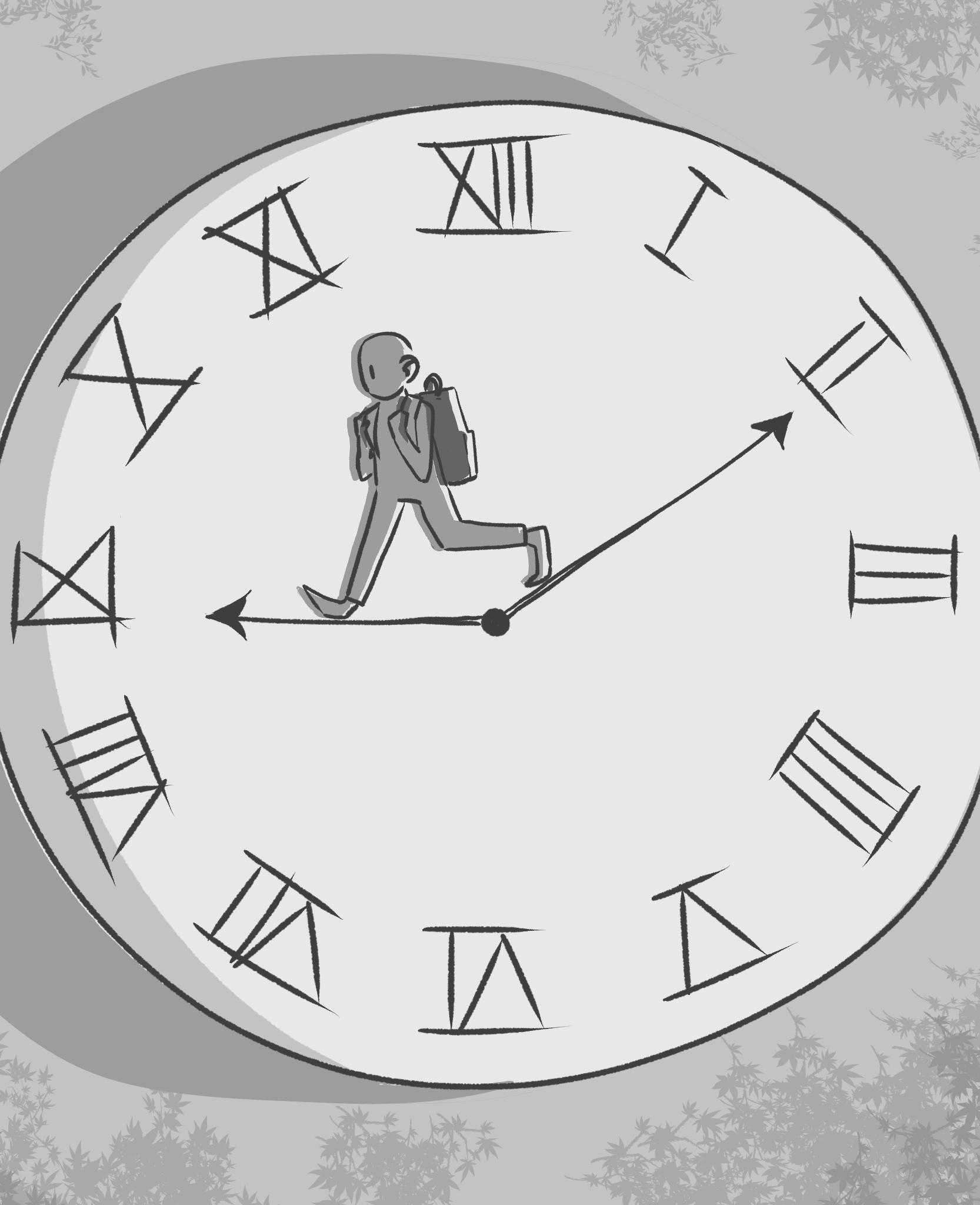
Stepping back and imagining that fickle cycle of small talk might add a calmer sort of awe to that panic, not fixing problems, but perhaps softening their blow. Small talk always remains calming, pleasant and fun.
That’s the standpoint from which I say, today, that this past week was kind of boring. It’s a break from the strict regimen of pre-set questions that we seem to collectively download every season. But when the tide of conversation ebbs again, it will be a welcome reignition of that realm of the commons, however imaginary they may be.
Emilio Esquivel Marquez PO ’25 is from Mexico City. He enjoys finding lost AirPods around the colleges, which helps him feel more engaged with the Claremont community.
37. ___ Outfitters
40. Suppressed
41. Valentine-ish sort of way a statement might be taken
43. Sovereign state
of exam or health 30. Agcy. that might deliver a valentine 31. “Her name was ___ / She was a showgirl” 32. They might sleep on the beach
Spanish honorific
Sources of ink in the Atlantic?
Blog’s kind of feed
They follow run or walk
It’s after uno and due
Ball’s perch
Response to “How are you doing?” 46. Conclude a Valentine’s Day card, say ... or a replacement in four of this puzzle’s across entries?
50. Trivia assist 51. Pretty frequently
52. Anthony on “Star Trek: Discovery” 54. Story sometimes used for storage
DOWN
1. Deposit spot, for short
2. Valentine, slangily
3. Conspiracy theorists, for some
4. Place to crash
5. De Armas in “Knives Out”
6. Designer Oscar ___ Renta
7. They hang out in dens
8. Some distance from here
9. Mangy hound
10. Devious Squalor in “A Series of Unfortunate Events”
11. “Promise me!”
12. “___: you’re a leaf with good crunch potential”
13. Amazement
21. Dichotomous kind of question
24. Luxury wrist item
25. Where many pharaohs were crowned
26. Running shoes with intersecting lines
28. Gloomy on Valentine’s Day, maybe
29. Like John Fetterman, notoriously
33. Film’s cylinder
34. Tiptoe
36. How a group might be split
44. Some hold hands while sleeping (aww!!!!)
45. Nonstop, flight-wise
46. Web presences
47. Place to go in
48. Classic Harlem dance hall, with ‘The’
49. Incantation from 50-down’s character
50. Kathryn on “WandaVision” (also an S-tier Pomona building)
53. Dancer’s bend
55. Walensky’s agcy.
57. Crosses (out)
LAST WEEK’S ANSWERS
PaGe 8 February 10, 2023 Opini O ns
JADA SHAVERS
eMMa JeNSeN • THe STuDeNT LIFe
LuCIa MarQueZ-uPPMaN • THe STuDeNT LIFe
JaSPer DaVIDOFF • THe STuDeNT LIFe ACROSS 1. Oscars broadcaster 4. :( 11. Place for a massage 14. Embattled conductor in a Best Picture nominee 15. Ominous chant as someone is being surrounded, perhaps 16. “My gosh!” 17. ___ culpa 18. Reason for undue panic 19. “Killing ___” 20. “Ciao!” over text 22. ___ Lingus (Irish carrier) 23. The Paleozoic, for one 25. Michigan or Ontario 27. Sort
38.
39.
34.
35.
37. Opening (an envelope)
41.
42.
43.
Michele
57. Comparison
measurements 58. Roman ruler
not a big fan of Jesus
56.
of dubious literacy
for elevation
who was
On February 2nd, the Scripps community gathered in the Garrison Theatre to see famed Palestinian comedian Mo amer take the stage in his standup set “Laughing Matters! Featuring Mo amer.” Then he said the N-word.
EMILIO ESQUIVEL MARQUEZ
Sagehen baseball heads into 2023 with high expectations, following historic 2022 run
As the Sagehens stepped up to the diamond in February of 2022 for their first game in nearly two years, players, coaches and fans had no clue they were in for one of the program’s best seasons in its history. Now entering 2023 ranked No. 2 in the SCIAC’s preseason poll, midnight has struck on Pomona-Pitzer (P-P)’s Cinderella story, and it should be immediately evident whether the glass spikes still fit.
Asserting themselves as the SCIAC’s hardest hitting offense, the Sagehens slugged and walked their way to a 32-14 record last season, their fifth 30-win season in team history and first berth in the NCAA DIII Regional Tournament since 2012. Through intense offseason training, including members of the squad competing on a summer-league team and heavy recruiting of a new firstyear class, the Hens are poised to make another title run in 2023.
All-Region starting pitcher Jake Hilton PO ’25 described how much one season can change the perception of a program.
“We didn’t have many expectations coming into [last] season,” Hilton said. “This season we have a big target on our back.”
That target is due in large part to the Sagehens’ offense. P-P led the conference in runs scored, home runs hit, and team onbase plus slugging percentage (OPS). Despite this, their greatest strength may be their patience at the plate. Head coach Frank Pericolosi spoke on how his team topped the SCIAC in walks drawn.
“It’s definitely something we take pride in, being disciplined yet aggressive hitters,” Pericolosi said. “We talk about finding ways to get good pitches to hit in every at bat … When you have your best hitters as very disciplined hitters … it’s contagious.”
Center fielder David Bedrosian PZ ’23, who piloted this offensive onslaught of discipline with a .516 on-base percentage (OBP), drawing nearly a walk per game on his way to leading the conference in OPS, reflected on the changes he made during his breakout campaign.
“The biggest thing for me was
walking into the cage every round with a plan,” Bedrosian said. “We’re hitters, we’re not swingers. It becomes really easy to control counts and get the pitches you want when you execute your plan.”
Although P-P’s performance in the batters box carried them to a hard-fought matchup against Chapman at Regionals, they were unable to match the Panthers’ dominance on the mound. Chapman’s rotation featured three of the SCIAC’s best four starting pitchers by earned run average (ERA), all of whom will be returning this season.
The Sagehens finished just fourth in team ERA, but for a hurler like Hilton, this offseason has been a boon for development.
“[I’m] trying to get my
velo[city] up. Trying to make better pitches and be more consistent with my misses, not wasting pitches … I want a better strikeout to walk ratio,” Hilton said.
Even if P-P is able to solidify their pitching performance, Pericolosi explained in October they had an even greater area to focus on this offseason.
“We weren’t an elite defensive team by any means,” Pericolosi said. “Everybody knows pitching and defense wins championships … We have to be better defensively.”
The Hens found themselves far below any other competitive SCIAC program defensively, committing 85 errors in 46 games, including a leagueleading 33 from shortstop Jimmy Legg PO ’25 alone. Even still, as a defensive leader, Bedrosian
Hang ten or just hang out, Claremont Surf Club is making waves at the 5Cs
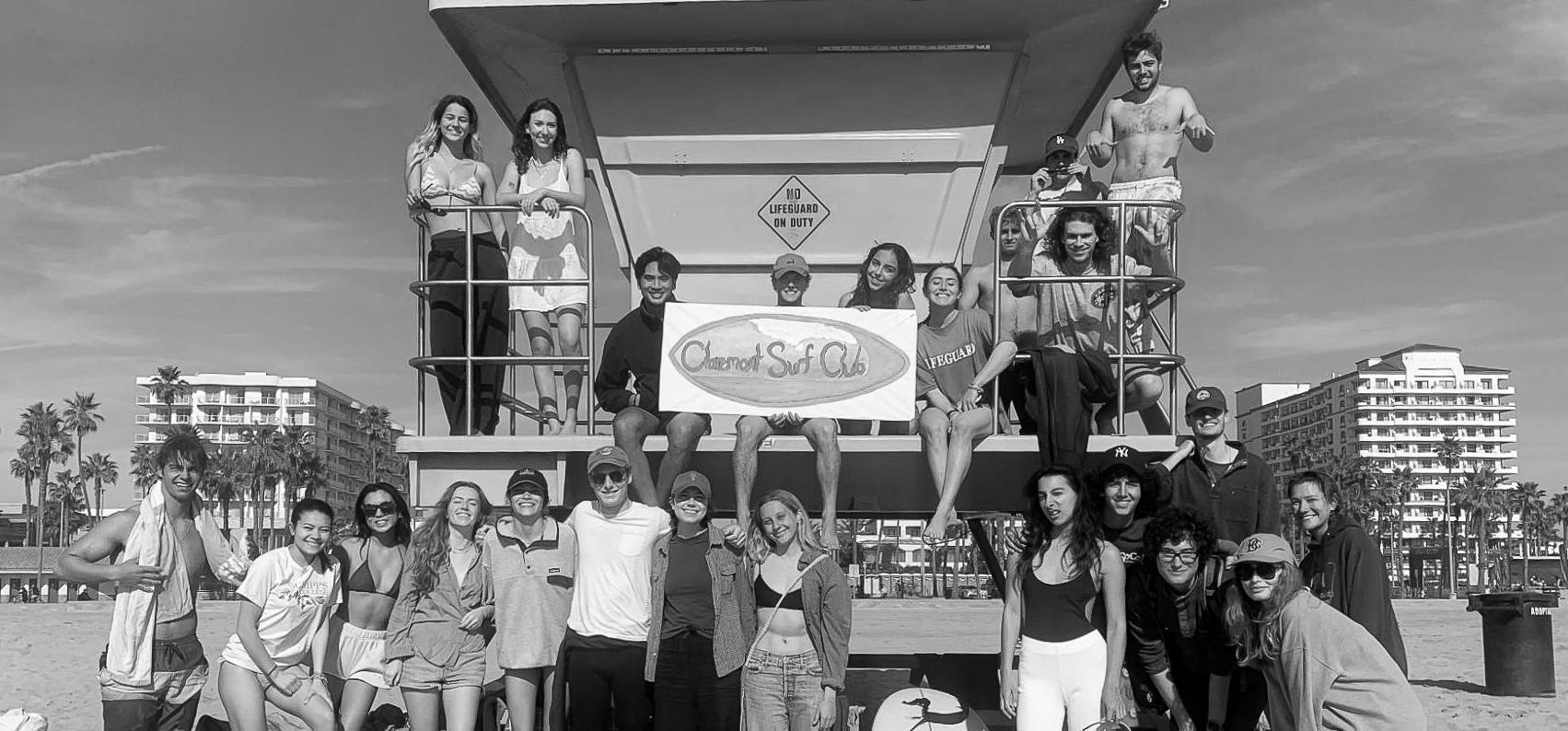
holds faith in his team.
“Our guys have been working really hard, especially in the infield they’re grinding every day. I’m very confident we’re gonna make improvements,” Bedrosian said.
Improvements can also come off the field. For Isaac Kim PO ’24, who was named the 2022 SCIAC Newcomer of the Year while slashing .379/.439/.662 last season, the path to achievement is largely mental.
“[I want to be] okay with not being perfect,” Kim said. “This is a game where you fail most of the time, and last year it kinda got to me when I didn’t have as much success as I wanted.”
Buying into offseason growth will likely be critical to P-P’s success this year. Some players took their dedication even further by playing for
independent summer leagues.
Ethan Collins PO ’25, who pitched for the Syracuse Spartans of the New York Collegiate Baseball League, believes that playing summer ball will help him achieve his long term goals in the sport.
“I’d like to take [baseball] as far as I possibly can, and [summer leagues] seemed like a good step to take,” Collins said.
For P-P athletes with hopes of playing at the next level, playing in summer leagues is a crucial step. Ryan Long PO ’21, who played for Cotuit Kettleers of the Cape Cod League in Massachusetts, was recently drafted by the Baltimore Orioles organization.

Playing for the Spartans also gave Collins a better understanding of what he needs to do to stay healthy as a pitcher during a long season.
Athletes of the Week
Pomona-Pitzer
Alexandra Turvey PO ’24
Vancouver, Canada
Women’s Swim
During the trying times of the pandemic, Nick Morgenstein PO ’23 found hope and enjoyment in surfing. The boredom, loneliness and instability he faced each day during quarantine led him to search for an outdoor activity he could do with his friends. His dedication overpowered the harsh cold waters of the San Francisco Pacific Ocean, allowing him to reconnect with the outdoors and nature.
After returning to campus, Morgenstein was excited to join Claremont Surf Club, the surfing team at the 5Cs, but much to his dismay it had been disbanded during students’ time away from campus. With his newfound passion and commitment, Morgenstein rebuilt the club and was ultimately elected president.
“The mission of the club is to mainly get people to surf and to connect with the ocean and with each other,” Morgenstein said. “It’s so fun because the club meetings basically consist of a group of friends surfing and being psyched that we’re catching waves. We are such an incredibly open, welcoming, and enthusiastic group.”
Since the club’s reinstatement, it has amassed over 400 students on their mailing list. Creative director Sylvia Bergerud SC ’23 credits this to the club’s active effort in catering to beginners.
“A lot of people on our mailing list haven’t surfed very much and are interested in trying it,” Bergerud said. “Our beginner days are meant to get as many people in the water as possible.”
The club hosts several beginner
days a semester. The more experienced surfers often act as mentors for the large number of beginners. Mark Tankersly CM ’24, who has been surfing since elementary school, helps coordinate and lead the beginner days.
“We get a bunch of boards from the lockers at Pomona and Pitzer, and we just split up into groups of 5-15 people on a couple boards,” Tankersly said. “We go out in the water, we push people into waves, give them instruction and just be there as a general guide. We try to let people have the freedom to have fun and do whatever they want while still being careful and instructive.”
Aside from the planned beginner days, the club doesn’t have any specific meeting times. The leadership often communicates weekly with more consistent members of the club and coordinates when they are available and what beach they want to go to. About 20-40 students make it to each session, and the club has traveled to a variety of beaches, including Huntington, Trestles, River Jetties, San Onofre and even Malibu.
In addition to hosting beginner days and regular beach days, the club houses a contest team for more experienced surfers.
Tankersly said it has been difficult to find other experienced surfers on campus because of the size and location of the schools and the independent character of surfers in general. As the coordinator of the competitive team, he is in charge of general outreach for advanced members.
“We did [a contest] last year and we’re trying to get a few more on the calendar for this year,” said Tankersly. “Most of them are pretty expensive, so they’re kind of hard to get funding for — especially because there are not that many [competitive] surfers here. We’re mainly trying to create a bigger group of surfers who have been surfing for longer and can go to spots that are a little more dangerous and require a little more skill.”
While the club is hoping to further build their contest team, anyone who has interest in learning is still highly encouraged to join. Bergerud says she enjoys surfing because she meets a new challenge every time she goes.
“It takes a bit of toughness to decide to put on my wetsuit and paddle through waves each time,” Bergerud said. “The water can be cold and it may be unpleasant at first, but afterwards, I always feel like the experience was worth it and I feel accomplished. Even if I didn’t catch a lot of waves, I always feel like I did something important with my day.”
Tankersly reiterated that having a group of people to surf with every week, making new friends and being a member of the greater surfing community at the 5Cs is the club’s main goal.
[The club is] just a really great community of people, both on campus and at the beach,” Tankersly said. “It has no expectations and no requirements … and it’s just a great opportunity to hang out with such genuine people.”
Alexandra Turvey PO ’24 earned the title of SCIAC Athlete of the Week for Women’s Swim on Monday, Feb. 6 after breaking a previous conference record. Turvey became the only women’s competitor to swim in under 1:50 in the 200-yard Freestyle, making a time of 1:49.92 last weekend at the CMS Invite. However, recordbreaking is no new feat for Turvey who has been an accomplished swimmer throughout her life, both for the Sagehens and for her country. In 2020, Turvey became a Canadian Olympic Trials Qualifier in the 50-meter Freestyle, demonstrating her ability to not only be successful internationally, but also in multiple events. The Sagehens will compete to defend the SCIAC title next Wednesday at the championship, hosted at East LA college.

Claremont-Mudd-Scripps
Josh Angle CMC ’23 Lake Oswego, OR Men’s Basketball
Josh Angle CM ’23 scored his 1000th point for Claremont-MuddScripps (CMS) on Wednesday night. He reached this milestone in the first half of what ultimately became a victory over the Chapman Panthers for the Stags, their 11th win in conference play. Though scoring 1000 points over the course of his college career is a huge accomplishment, this success was not uncommon for Angle. In his first year, Angle appeared in 20 games and averaged 4.5 points overall, but managed to score 15 points over Sixth Street Rival Pomona-Pitzer. In the 2021-2022 season, the next year the Stags competed, Angle was a starter in each of his 24 appearances, and averaged 18.8 points for the Stags. This will be Angle’s last season competing for CMS, who will next appear on the road this Saturday for a 4:00 p.m. battle with the Occidental College Tigers.

February 10, 2023 PaGe 9 Sport S
HAROLD FUSON & BEN LAUREN
abbey LIaO • THe STuDeNT LIFe
all-region Sagehen JC Ng PO ’25 prepares to swing during a game in the 2022 season.
SENA SELBY
Claremont Surf Club poses on lifeguard tower during a trip to Huntington beach.
COurTeSy: CLareMONT SurF CLub
‘Season still up for grabs’: P-P women’s basketball looks to move ahead after dramatic loss to Panthers
The crowd at Wednesday night’s women’s basketball game didn’t know what they were in for as they filed into an echoey Voelkel gymnasium at Pomona College’s new Center for Athletics, Recreation and Wellness (CARW).
In what ended up being a nailbiting, dramatic last-minute loss, the Pomona-Pitzer (P-P) Sagehens women’s basketball team fell to the Chapman Panthers 66-62 in one of their last home games of the season.
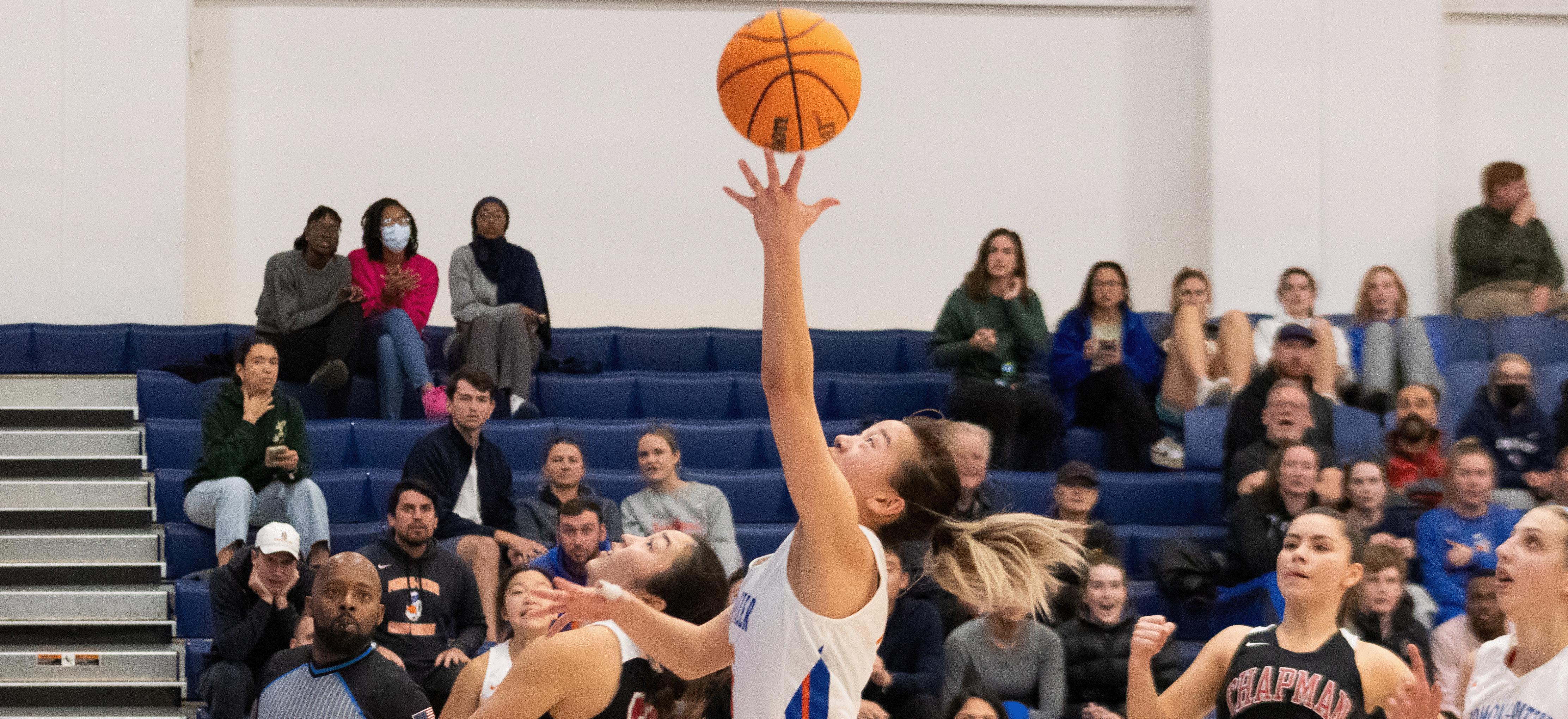
Senior Emily Church PO ’23, who plays forward for the Sagehens, led the team in rebounds that night. Despite the strong performance from the team, the Sagehens couldn’t quite close the gap after suffering a wide deficit early on in the game.
“It’s obviously a tough [result] because we go back and forth with Chapman,” Church said, referencing the Sagehens’ win against the Panthers in January, “but the postseason is still up for grabs.”

The Sagehens went down early in the first quarter, at one point
trailing 16-8, but recovered with strong steals and fastbreaks from player Kaitlyn Leung PO ’23. The first quarter ended 22-20 in favor of Chapman. Chapman started the second quarter strong, scoring twice within the first few minutes to make the score 27-20. The Panthers’ aggressive defense, however, created many free throw opportunities for P-P, which Maison Yee PZ ’25 and Anna Revill PO ’26 capitalized on. Still, the Sagehens were down 39-31 to close out the first half.
The third quarter started off poorly for the Sagehens: after a scoring frenzy by the Panthers, P-P was down by 15 points (4833). The Sagehens’ head coach Alaina Woo called a timeout which Madison Quan CG ’23 said helped to re-center the team’s focus.
“I think Coach Woo does a really good job of keeping us calm,” Quan said. “She likes to keep us composed, which is super important.”
Woo’s talk must have worked wonders for the Sagehens, who went on to score eight points
straight following the break, prompting a call for a timeout by the Panthers. The third quarter ended 59-50 still in favor of Chapman.
P-P kept up their scoring streak at the start of the fourth quarter, coming within one point of the Panthers with the help of individual scoring efforts from Katie Drais PO `26 and Leung, two players who Quan said are instrumental both on and off the court for P-P.
“The energy that [Drais] brings, whether she’s on the bench or on the court, [is] always next-play mentality,” Quan said. “That’s something that we really need on our team because basketball is an emotional sport and you’ll get down on yourself, but Katie’s always there to pick you right back up and when she goes in she makes a huge impact.”
As part of the Sagehens’ large first-year class along with Drais, Kellie Au PO ’26 said it’s especially important to have upperclassmen role models who step up big in the moments when it’s needed.
“Leung is like [the] number
1.
one, go-to girl for hustle,” Au said. “She is the heart and hustle of our team.”
The score was 61-60 in favor of Chapman with two minutes left, and the crowd at Voelkel started to get on its feet. The Panthers scored, however, making it 6360 with 1:19 left on the clock.
Two free throws awarded to P-P, both scored by Quan, gave the Sagehens some hope with one minute left. Chapman called for a timeout, starting with the ball afterwards, but P-P stole it and looked to mount a counterattack, but gave the ball away before the attack fully developed.
After a P-P foul, Chapman got two free throws, both of which they missed. Thirty seconds remained in the game — if P-P could score just once, the game would be theirs. Nevertheless, a steal by Chapman made the score 65-62 with three seconds left, and an additional free throw awarded to the Panthers sealed the game, making the final score 66-62.
“I feel like in the last minute, the biggest thing we were thinking was ‘just one more minute, we need to execute a
good 30 seconds, just like stuff in practice and then execute on offense’ which we faltered on,” Au said. “But…it comes down to the entire game, not just the last 30 seconds and that [was the message in the] locker room.”
Despite the players being upset about such a tough loss, the atmosphere in the locker room post-game was encouraging and inspiring.
“[Coach Woo] talked a lot about the deficit and getting down by 15 but [being] really proud of us for climbing our way back up,” Quan said. “[It’s] just knowing that we… have to start strong and [that] we have the talent and the ability to do so.” Quan said the team hopes to carry this confidence through to the end of the season.
“We’ve just gotta push through,” Quan said. “We can’t let one loss bring us down, we’ve gotta learn from what happened tonight … like Coach said in the locker room, the season is up for grabs, so we have to think about it as if this is our opportunity to make the playoffs and I think with our team we can do that.”
Athenas water polo roast and serve Sunbirds 11-8 in home opener victory

heading into the second quarter.
The second quarter was full of action, with goals from both teams. Early on, the Sunbirds scored twice to draw even at 3-3. The Athenas responded with goals from Clark and Cooper McKenna CM ’24, putting the Athenas back in the lead 5-3. After the back-toback goals from the Athenas, the Sunbirds scored on a powerplay with a mere two seconds left in the second period, bringing the score to an uncomfortably close 5-4 heading into the second half.
Seemingly unbothered by the tight score, Clark entered the second half confident in her team’s ability to pull ahead and solidify their lead.
“We wanted to pick up our intensity in the second half, and I know we had it in us to push ahead,” Clark said.
of the team as really selfless and motivating because everyone is always wanting the best for one another and we support each other everyday in practice and games,” Clark said. “On a good day or a bad day, they’re always there to lift you up and make you feel better. It’s super fun to be a part of because the energy at practice is always happy and upbeat.”
Echoing Clark’s sentiment, Power adds that their success is no doubt due to the relationships they have built both in and out of practice.
“We have always had really good team chemistry and we’ve always been super energetic with each other,” Power said. “I think that creates a good community where everyone can flourish.”
anna Fry HM ‘21 had three goals and three assists against Whittier in 2019 season.
AUDREY SAWYER
With a rough trip to Long Beach and Playa Vista in the rear view mirror, the Athenas were on the hunt, returning to a packed house at Axelrood Pool for their home opener. The Claremont-Mudd-Scripps (CMS) women’s water polo team claimed its first victory of the season Saturday, defeating the Fresno Pacific University Sunbirds 11-8. The victory followed two losses on Jan. 24th against ranked Division I teams Long Beach State and Loyola Marymount University.
In response to their recent losses, Jessi Beyer SC ’23 made it clear
the Athenas came into the game hungry for a win.
“Those were good games [against] good teams, but I think this definitely is preparing us for what’s to come in a couple of weeks,” Beyer said. “Our mindset coming into this game was to come out strong with a lot of heavy pressure, listen to our center defenders, communicate with one another and go as hard as we can, push the tempo.”
Beyer’s teammates shared her enthusiasm for getting back in the pool as they looked to secure their first win. Elise Power CM ’25 spoke of the home-pool advantage.
“Coming off of two losses was
okay because playing at home, the energy is a lot different,” Power said. “Playing a team that isn’t as high ranked [in] Division I definitely gives us a sense that we’re going into the game to just have fun instead of going in for a win … it’s still a really good experience for us.”
The positive attitude and energy of the crowd appeared to help as the Athenas started the game off strong with a 2-0 lead after two back-to-back goals from Christina Kulick CM ’23 and Mia Adsen SC ’24. Despite the Sunbirds’ first goal, CMS’s Grace Clark CM ’26 quickly returned the favor, leaving the score 3-1
The Athenas started off the second half with a goal from Kulick, followed by a second from McKenna and Clark’s third. The Sunbirds had a muted showing in the third quarter, only managing to put one on the board, leaving CMS with a solid 8-5 lead heading into the final quarter.
The Athenas started the fourth quarter strong, adding back-toback goals to create a comfortable cushion at 10-5. Although the Sunbirds would score three in the quarter, Dara Schoolcraft CM ’25 put the nail in the coffin, finishing off Fresno Pacific 11-8.
Reflecting on the win, Clark mostly attributed their success to the team chemistry and culture they have created.
“I would describe the character
With a positive attitude, Beyer is looking ahead as the Athenas inch closer to conference play.
“We have a group of 10 [firstyears] that are extremely talented, so I’m excited for what’s to come, said Beyer. “I’m looking forward to winning SCIAC, winning NCAA and having fun along the way.”
Adding a win to their record, the Athenas now sit at 1-2 where they look forward to eight more preseason games before heading into regular season conference play where they are currently predicted to finish second in SCIAC (following the Pomona-Pitzer team who also sits first in Division III preseason power rankings.)
CMS will return to the pool on Feb. 17th when they face off against Biola University at Fresno State in the first game of the Fresno State Invite.
PaGe 10 February 10, 2023 Sport S
AMALIA KOCH
eMMa JeNSeN • THe STuDeNT LIFe
Madison Quan CG ‘23 drives from the top of the key to the basket during Pomona-Pitzer’s 66-22 loss at home versus Chapman on Feb.
aNNa Fry • THe STuDeNT LIFe
GRACE SAUERS, Production Editor EMMA CONSTABLE, Production Editor JACK STEIN, News Designer KYLIE MIES, A&C Designer PAUL YAN, Opinions Designer SELINA LU, Sports Designer JULIA VICTOR, Copy Chief DANIA ANABTAWI, Copy Chief CHASE WADE, Photo Editor WENDY ZHANG, Photo Editor BELLA PETTENGILL, Creative Director SARA CAWLEY, News Editor MAXINE DAVEY, News Editor JAKE CHANG, News Associate GUS ALBACH, Data Associate INDIA CLAUDY, Arts & Culture Editor TANIA AZHANG, Arts & Culture Editor EMMA NEWMAN, Arts & Culture Associate ABBY LOISELLE, Opinions Editor ELENA TOWNSEND-LERDO Opinions Editor BEN LAUREN, Sports Editor ANSLEY WASHBURN, Sports Editor JENNA MCMURTRY, Special Projects Editor ANURADHA KRISHNAN, Special Projects Editor ANNIKA WHITE, DEI Editor MANAN MENDIRATTA, DEI Editor HALEY WEBB, Business Manager CLARE A’HEARN, Social Media Manager YAHJAIRI CASTILLON, Social Media Manager KANA JACKSON, Multimedia Editor SEOHYEON LEE, Web Developer LIZ JOHNSON, Web Developer THE STUDENT LIFE HANNAH WEAVER, Editor-in-Chief AVERI SULLIVAN, Managing Editor GERRIT PUNT, Managing Editor TSL’s Editorial Board consists of the editor-in-chief and two managing editors. Aside from the editorial, the views expressed in the opinions section do not necessarily reflect the views of The Student Life. Singles copies of TSL are free and may be obtained at news stands around campus. Multiple copies may be purchased for $0.47 per copy with prior approval by contacting editor@tsl.news. Newspaper theft is a crime; perpetrators may be subject to disciplinary action as well as civil and/or criminal prosecution. Editorial Board Senior Staff SaSHa MaTTHeWS • THe STuDeNT LIFe






































